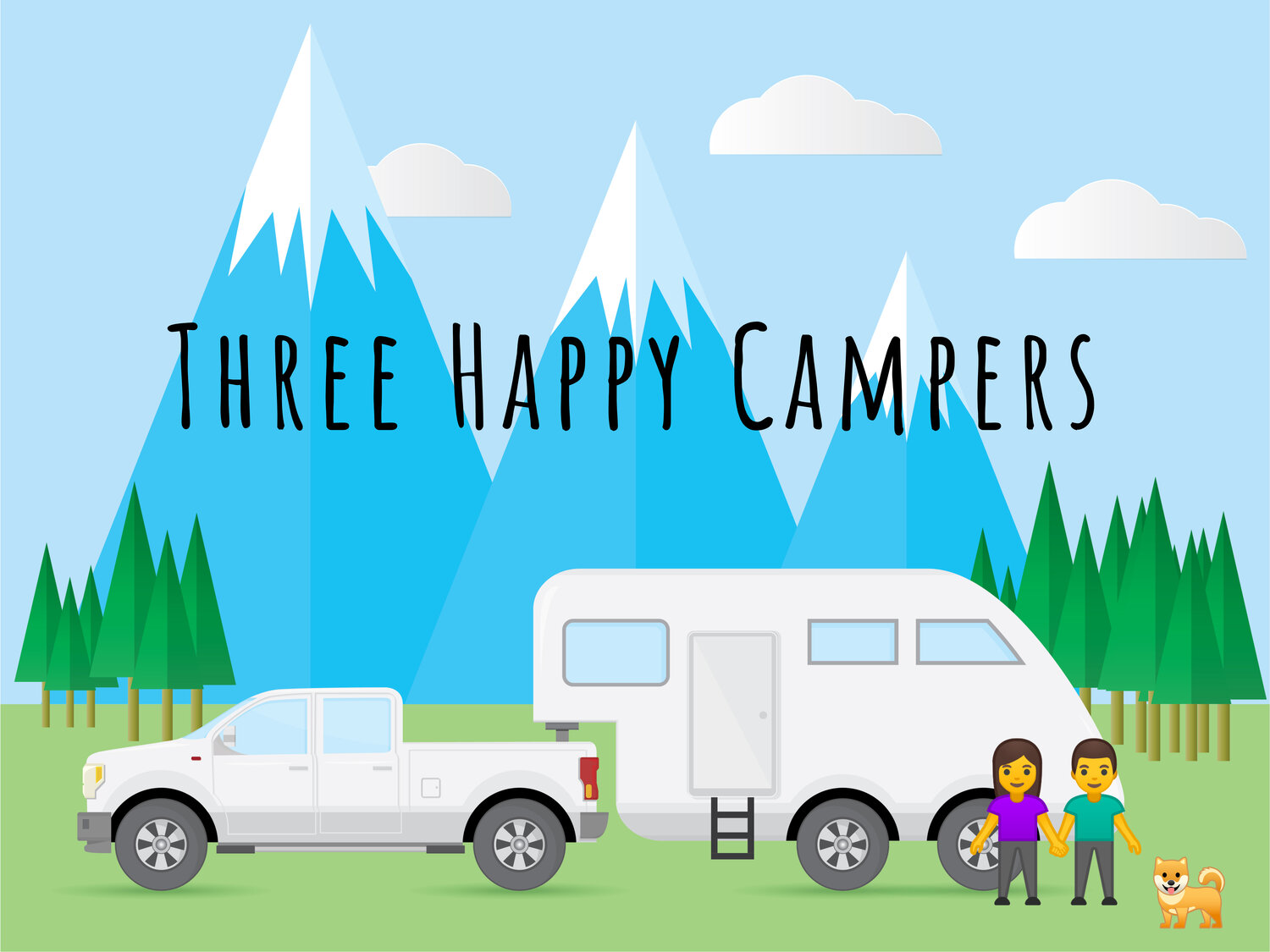California-Land of Fruits, Nuts and Beauty
Hi Everyone!
After our last update, many assumed we were on the road again; we are not, but we are taking another extended trip soon. We are finalizing our schedule and look forward to sharing our plans in an upcoming post.
In this piece, we're sharing the things we experienced during our two-week tour of California last fall. Beginning in Death Valley, we worked our way north, to Yosemite and Kings Canyon National Parks and Sequoia National Forest. We then stopped in San Francisco for a couple of days before traveling another 500 miles south almost to the border of Mexico, and then east to Lake Havasu. Lake Havasu marked the beginning of our eastward travels to be home for the holidays.
From the 1840s gold-rushing pioneers to the road-tripping hippies of the 60s, natural resources, an enormous coastline, farming, and various industries of the Golden State have enticed and attracted different kinds of people. The vast beauty and allure can sweep you away to another dimension at times. In our humble opinion, some residents here have been swept too far into another dimension and have not come back. 😄 You will see this reflected in some of the places we went toward the end of our tour. Many photos and captions featured do not begin to tell the fascinating history or rich details of the story they represent. While I'd be delighted to write a small book on each one, I’ve moved on because you very well may not care for every detail! We learned about and enjoyed so many different things, but some of our favorite stops were at features that have been here for hundreds, if not thousands of years.
Our youngest son, Chris, and daughter-in-law, Ambrey, timed their visit to explore Death Valley, Yosemite, and Kings Canyon National Parks. We enjoyed each place as if it were our own secluded backyard; at Kings Canyon, we saw only a few other cars the entire day. It felt magical in a sense, to be virtually the only ones in these majestic places. During the entire visit, the four of us would repeat, "More Blessings!" over and over at each new discovery.☺️
We hope you enjoy our photos as much as we enjoyed taking them, and that you are experiencing more blessings every day in the simple pleasures in life. Much love to you all!
Craig and Glenda 😀

Think you have problems with asses around you? You may not get much sympathy from some of the residents of Beatty, Nevada. This small town is known for its wild burro (over) population. The town has historically embraced the burros as symbols of the community's roots, but with donkeys increasing their population by 20% each year, things get out of hand. A few years ago, over 900 asses were pushing down fences, getting into loud fights, and eating and stomping vegetation, causing the Bureau of Land Management to come and remove 400 animals. While that was helpful, they still had 4 times (about 300) more donkeys than can be sustained by this small town. The bright side is with so many burros walking on and near the roads, it's easy to enforce their 25 mph city-wide speed limit!
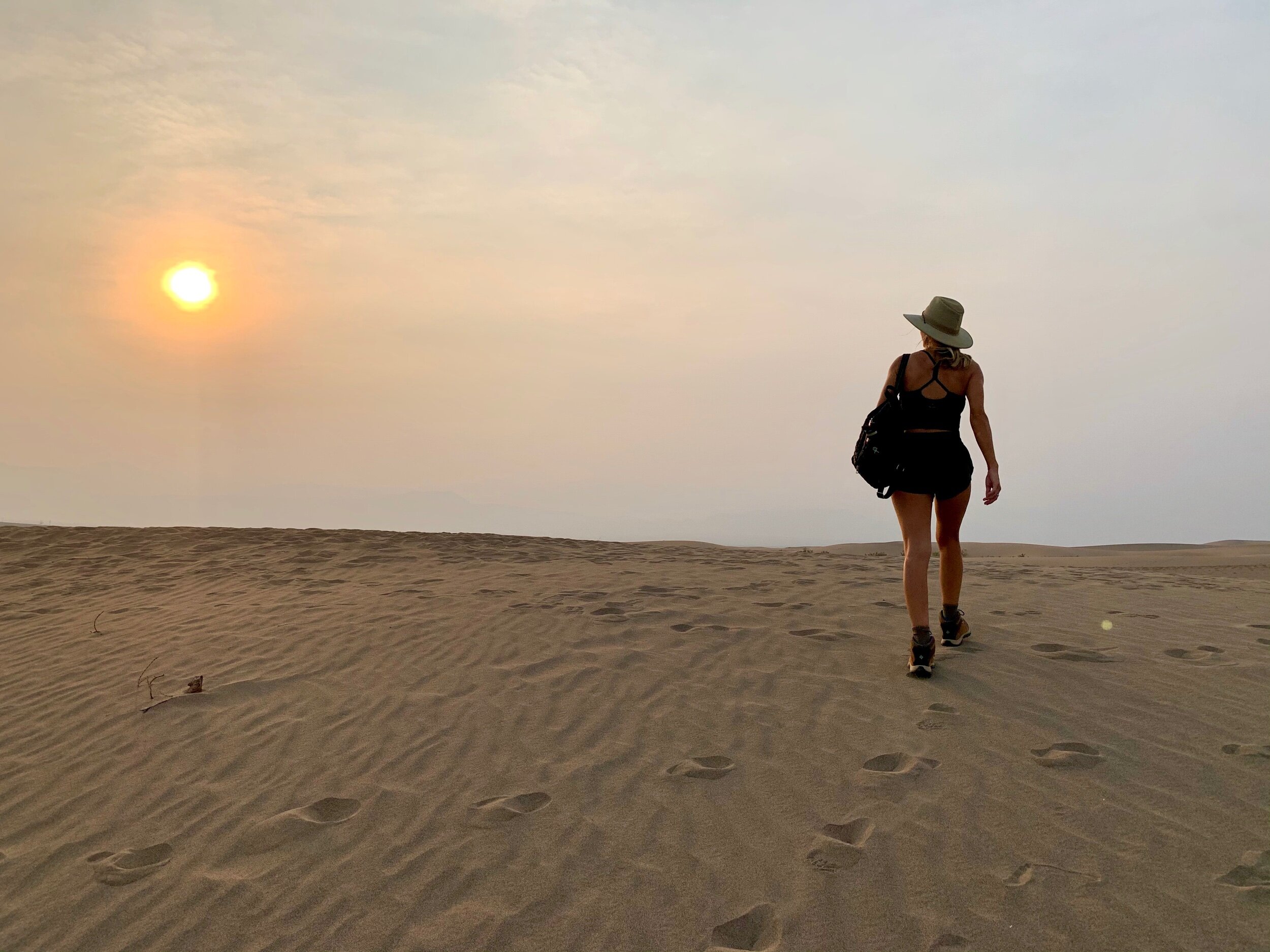
All those National Geographic episodes that feature the hot sand, cracked ground and deadly heat of Death Valley came to life as we visited here. Death Valley extends 3,000 square miles and is one of the hottest and driest places on earth, along with deserts in the Middle East and Sahara. Here, Ambrey makes bearing the heat look easy, and even glamorous.
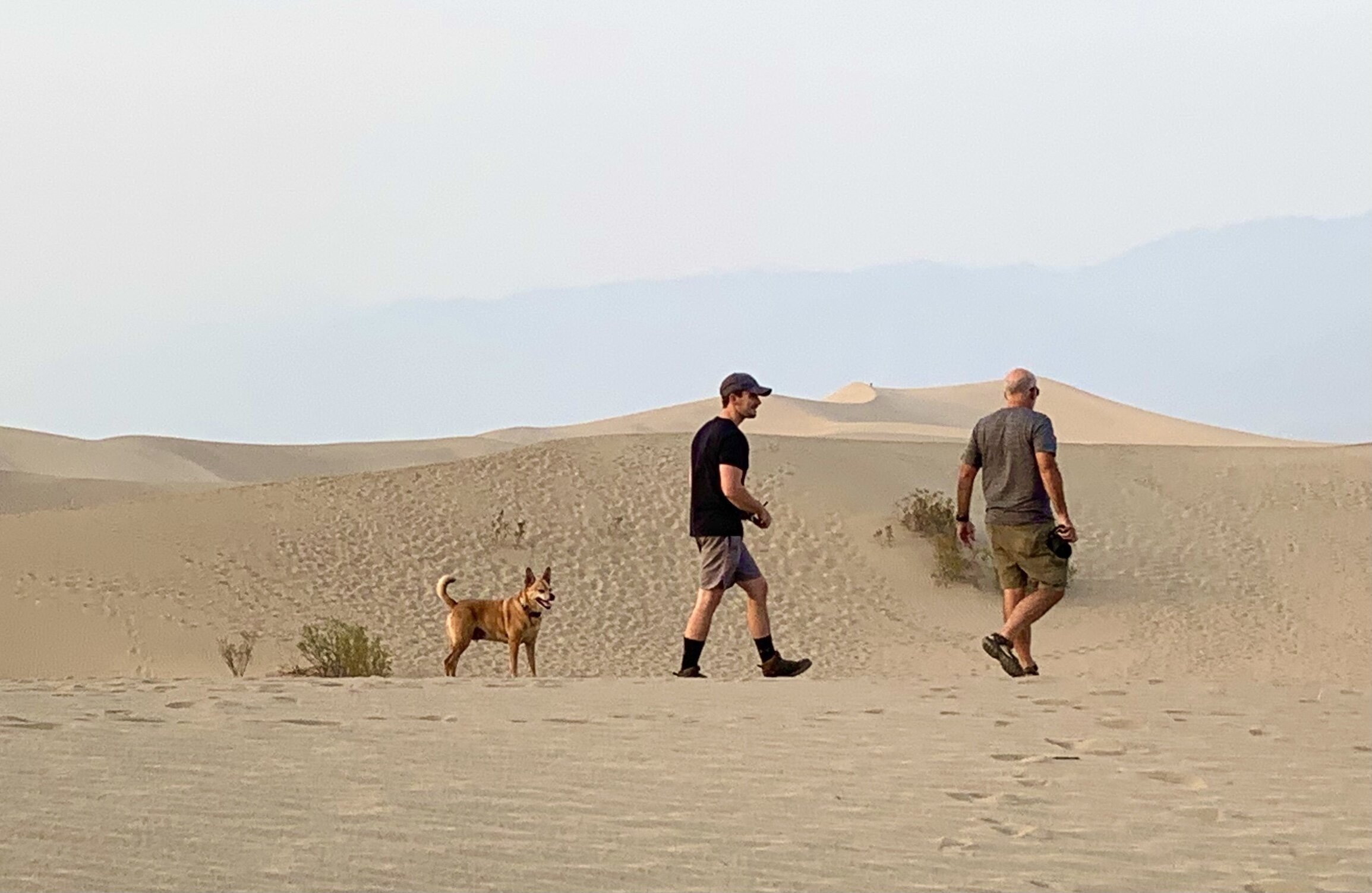
I was most amazed with how remote this area is. I suppose I should have known, but there is nothing here. A long list of movies have been filmed here, including Star Wars, Return of the Jedi, and multiple episodes of the Twilight Zone series in the 1950s.
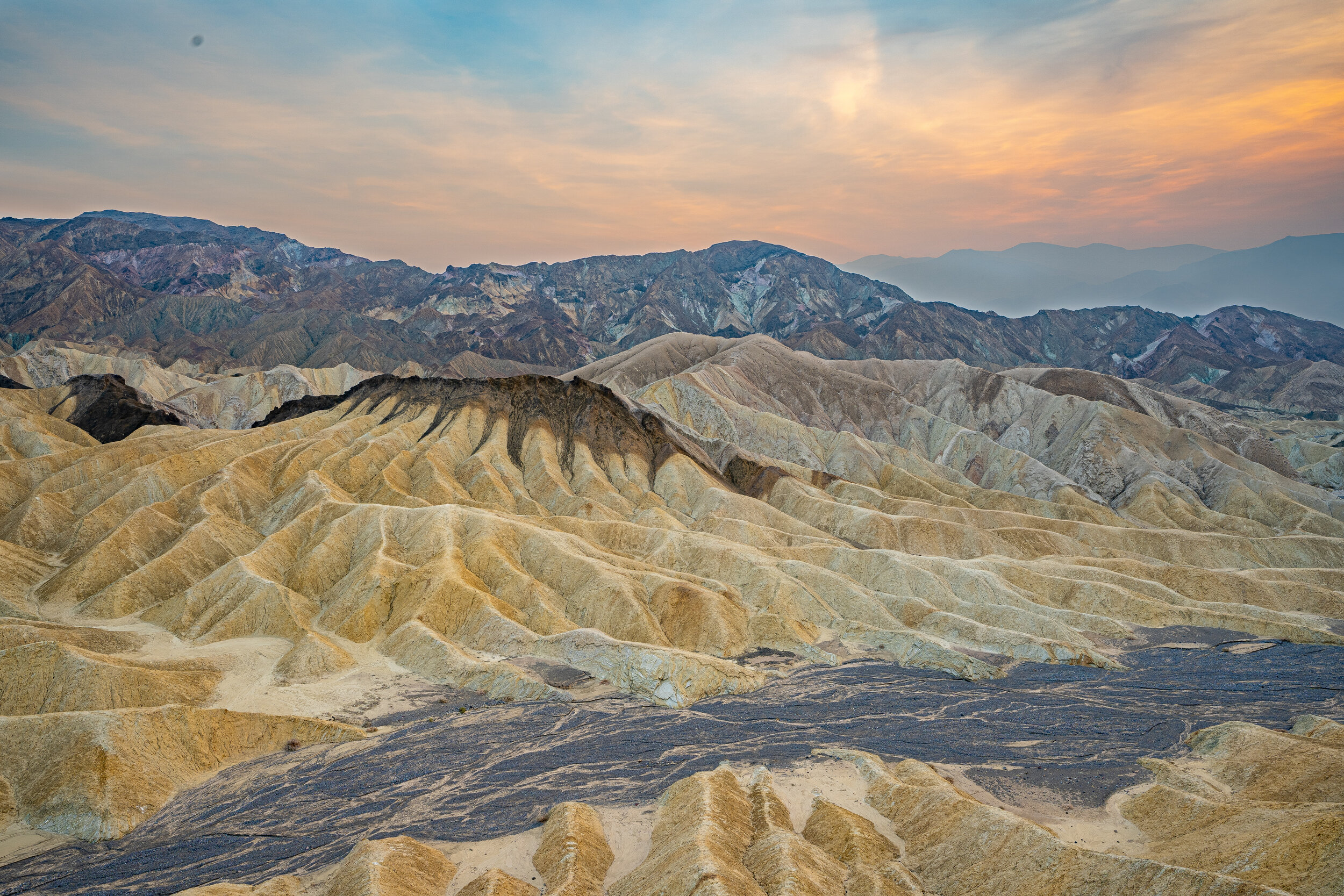
Borax is a natural mineral commonly used for laundry detergent and 100 other uses, much like baking soda. Borax was mined from this area in Death Valley from 1881 until 2005. Craig and Chris enjoyed hiking on the enormous mounds as Ambrey and I enjoyed the sunset.
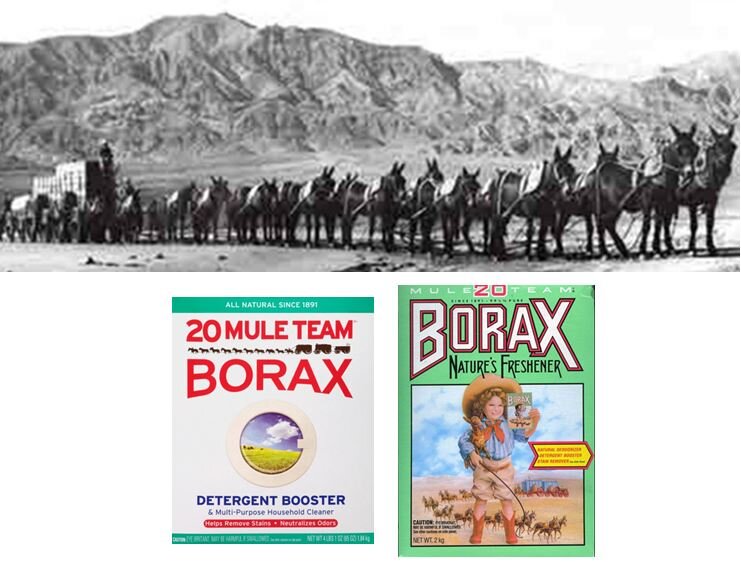
The brand name of Borax laundry detergent that we still see today, 20 Mule Team, and the mules on the box refers to the revolutionary way the borax was taken from the mines in Death Valley. The 2-horse, 18-mule teams were famous for pulling the massive wagons that carried 10 tons of borax out of the mines at a time. This photo was taken sometime before 1896, when the teams were replaced by railroad. The famous teams are still remembered at the The Mule Team Borax Terminus, a California Historical Landmark in Mojave. The borax mounds in the background of the photo look just like they do today.
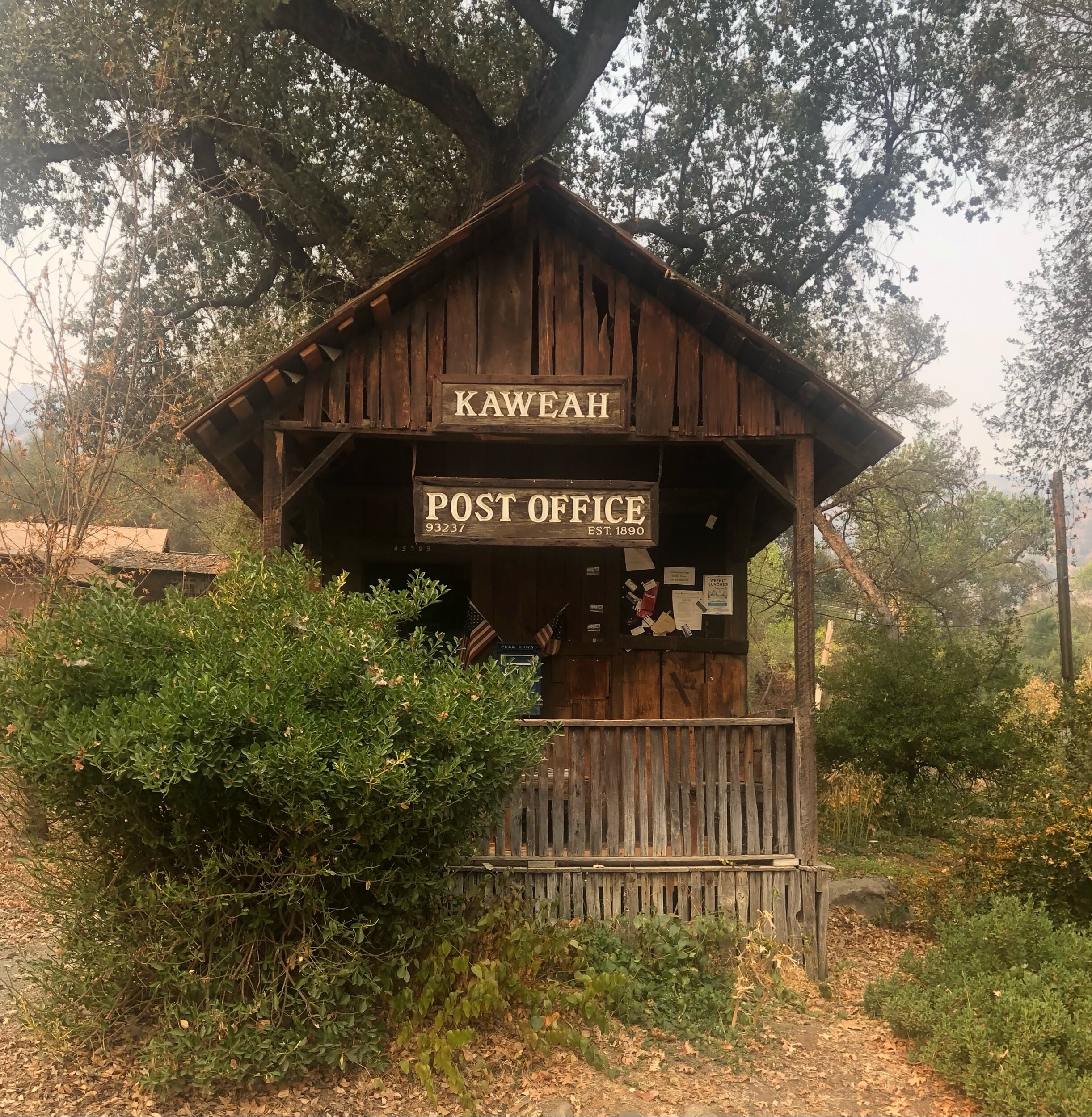
Kaweah's still operational, 12 x 15-foot post office appears to lead the pack in the Oddest Origin category. Someone even wrote a book specifically about this community and the social experiment involving 500 non-conformists from San Francisco that settled here. The landmark sign reads: "[The Kaweah Colony] was a utopian project started in 1886. For several years, it attracted international attention, and many settlers came here and actually did much to further their ideals. Unable to secure the title to the land and because of internal difficulties, the organization ceased to exist after 1892. Leaving as one of its tangible reminders, [this] Kaweah Post Office." Part of the trouble in paradise began when the community members started chopping down a bunch of trees, and the government stopped them. Interestingly, the efforts to protect the trees from the utopians resulted in California's first national park, Sequoia National Park.
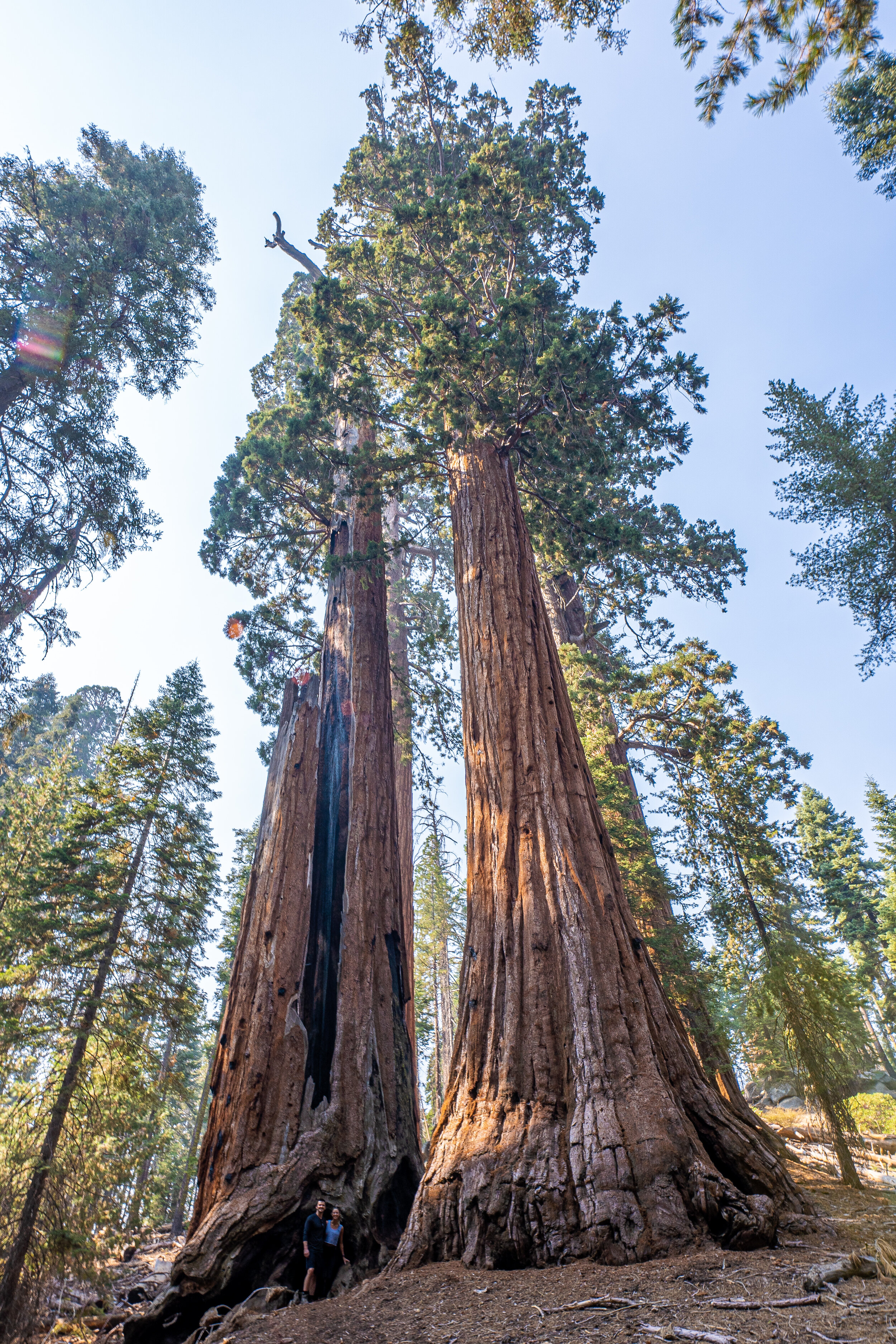
Kings Canyon National Park connects with Sequoia National Park. Sequoia NP had yet to reopen on the day of our visit, but we still got to enjoy the enormous sequoia trees here.

Early pioneers told folks on the east coast about the giant trees in California, but no one believed them. At least three nearby sequoias died just to prove they lived. Cut into pieces, they were shipped across the country to exhibit as freaks. Some still hang in New York and London museums today. A 16-foot cross section of a tree from this park was sent to the Philadelphia Centennial Exhibition of 1876. It took two men nine days to chop down the tree. With only the outer shell on exhibit and the parts being reassembled after shipment, Eastern people refused to accept the exhibit as part of a single tree. They laughed it off as a "California Hoax."
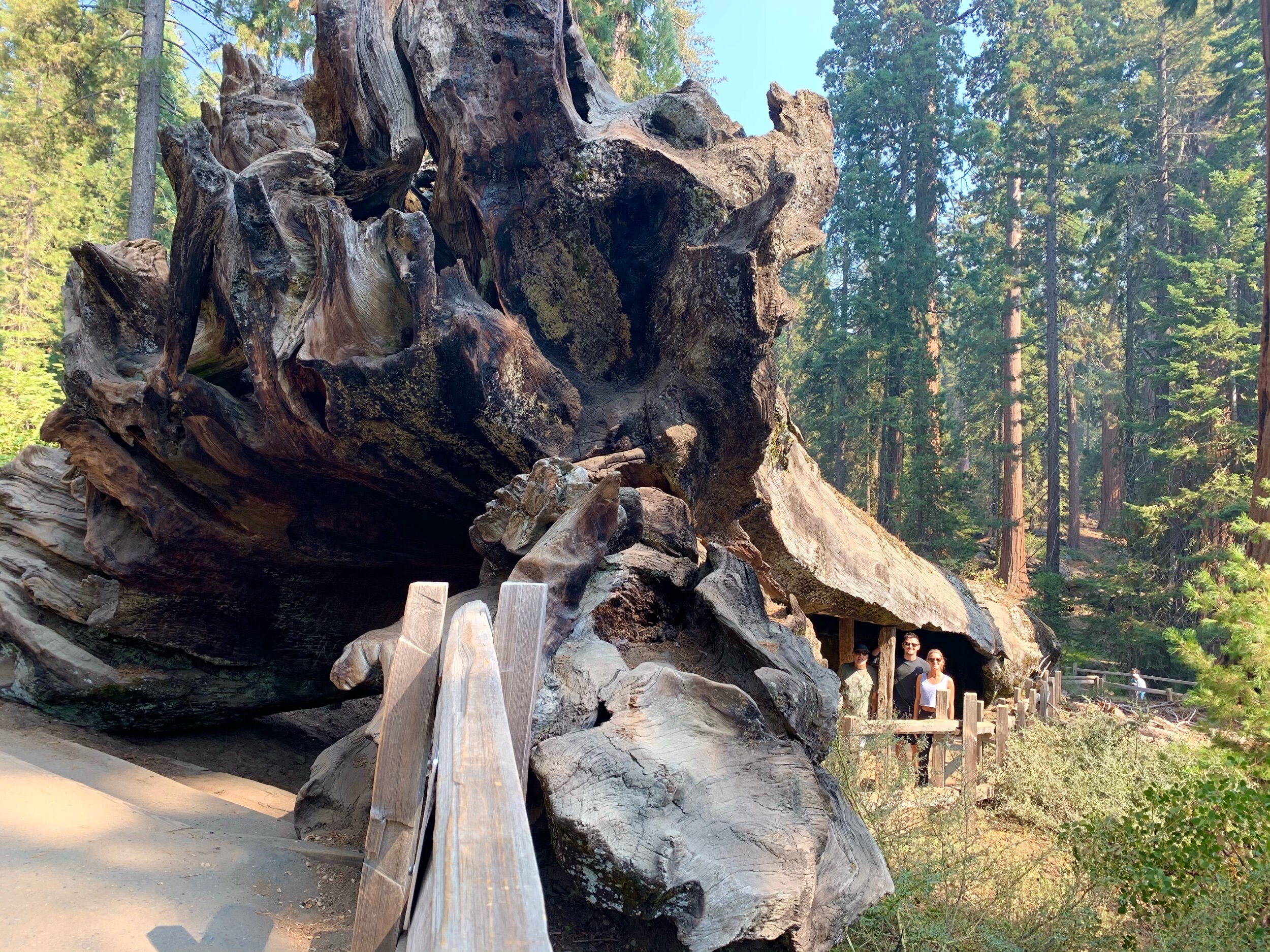
Fallen Monarch Tree was mostly hollowed out by fire before it fell over 300 hundred years ago. It was used as a living space for two loggers while building a ranger's cabin in the park. Over the years, Fallen Monarch has served many purposes, including a horse stable for the US Calvary in 1890, and a saloon and hotel from 1890-1914. 😲 Ambrey, Chris, and Craig stand in the middle portion of the trunk.
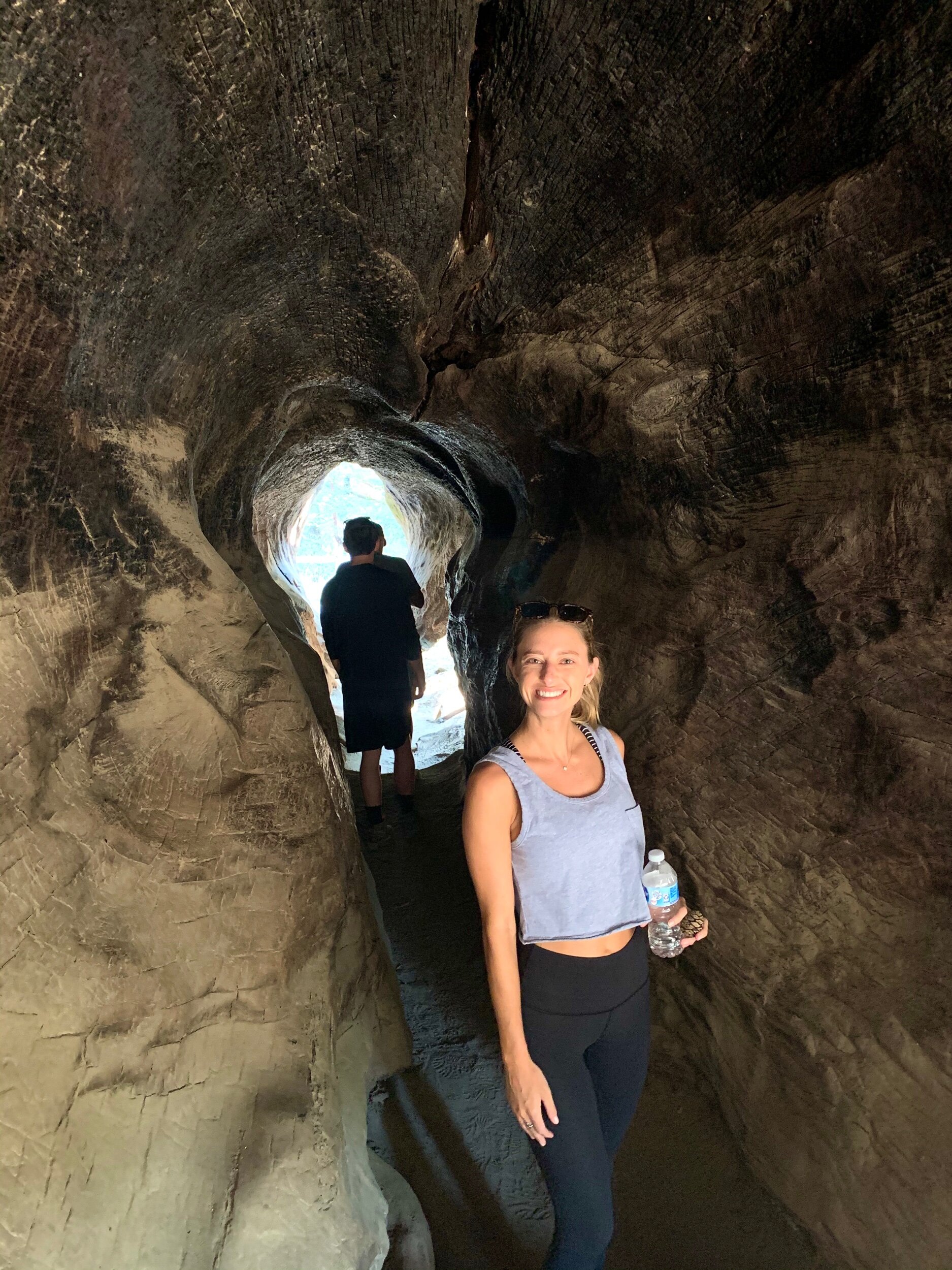
Fallen Monarch has two full-sized entrances, and plenty of room inside to move around, giving a great appreciation for how big these trees really are.
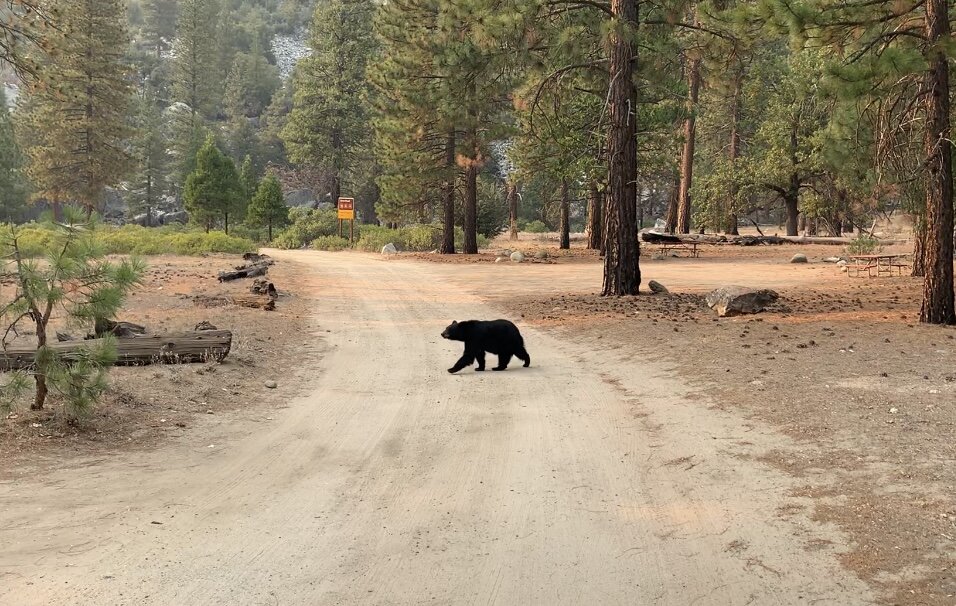
While driving through the park, Chris spotted a bear walking in a wide open field next to the road. Not much is more exciting that a bear sighting. 🐻 We experienced quite a treat; the bear walked past our truck, over to the river and took a bath as we watched from the bridge. More on the bear in our video below!
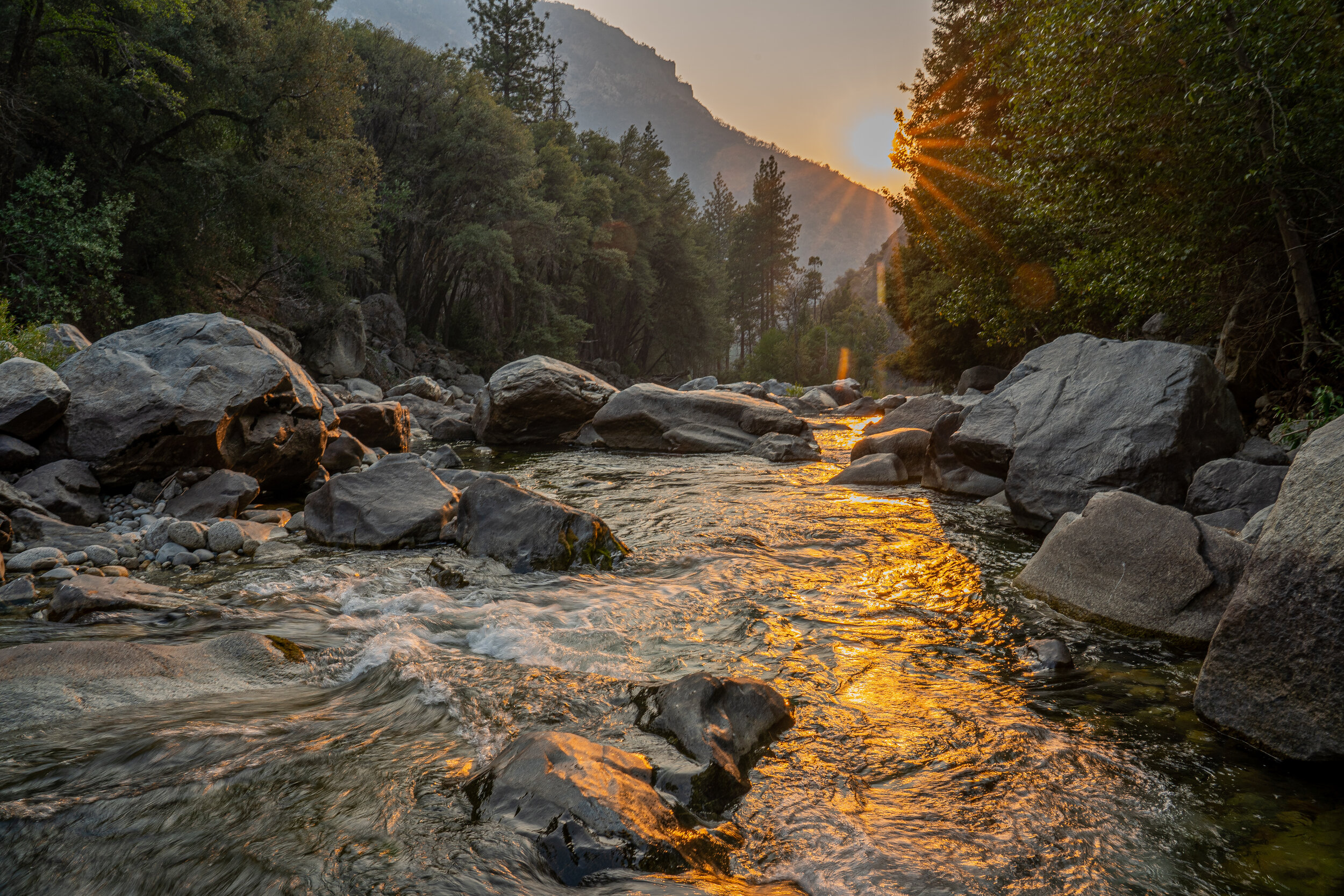
Before leaving Kings Canyon, we were treated with a beautiful sunset in this deserted place.
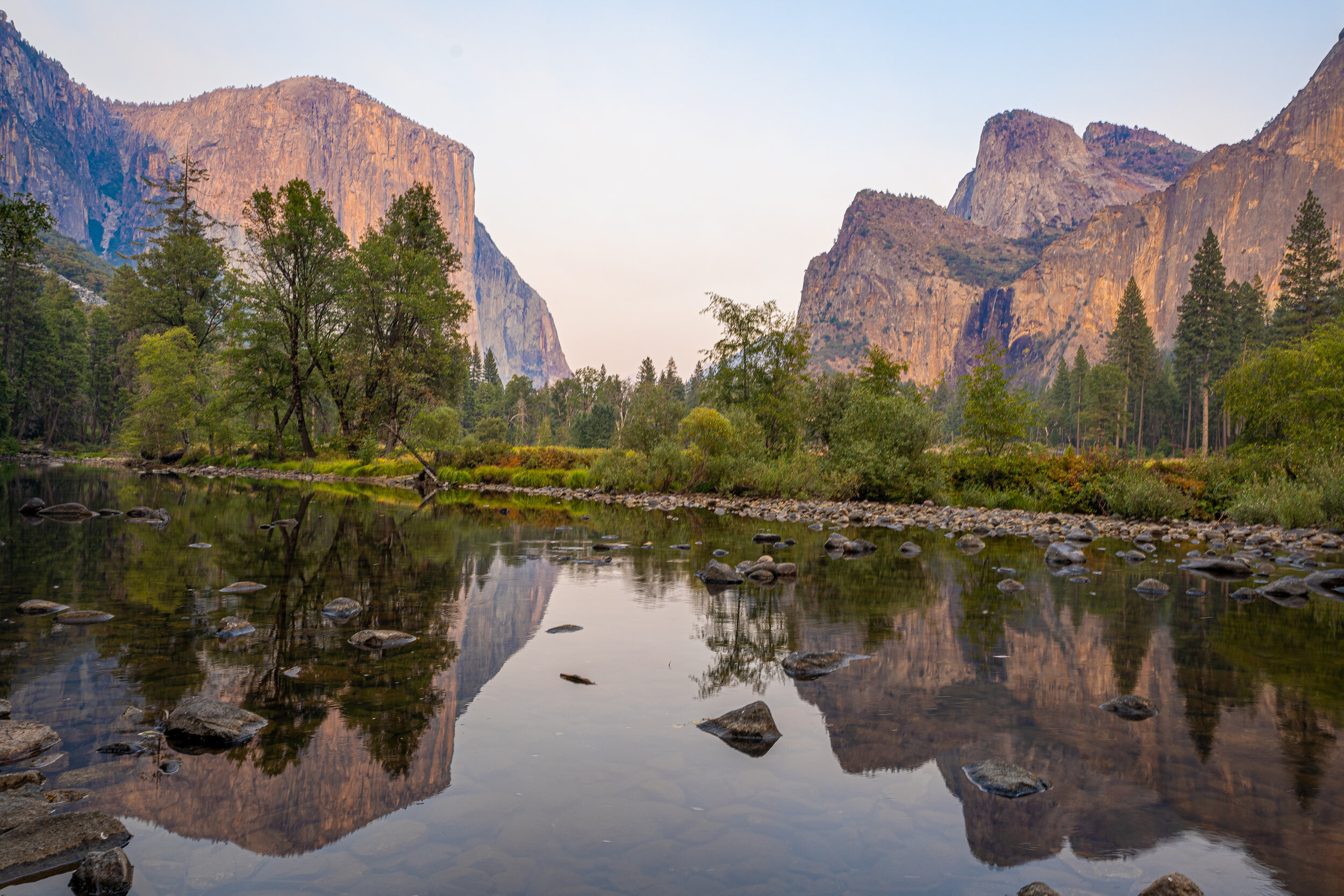
We made it, Yosemite National Park! This iconic view of Yosemite Valley features El Capitan, on the left, one of the most iconic rock formations in the world, and Half Dome, behind the shortest mountain on the right. The water in the valley is like crystal and perfectly reflects the mountains above.
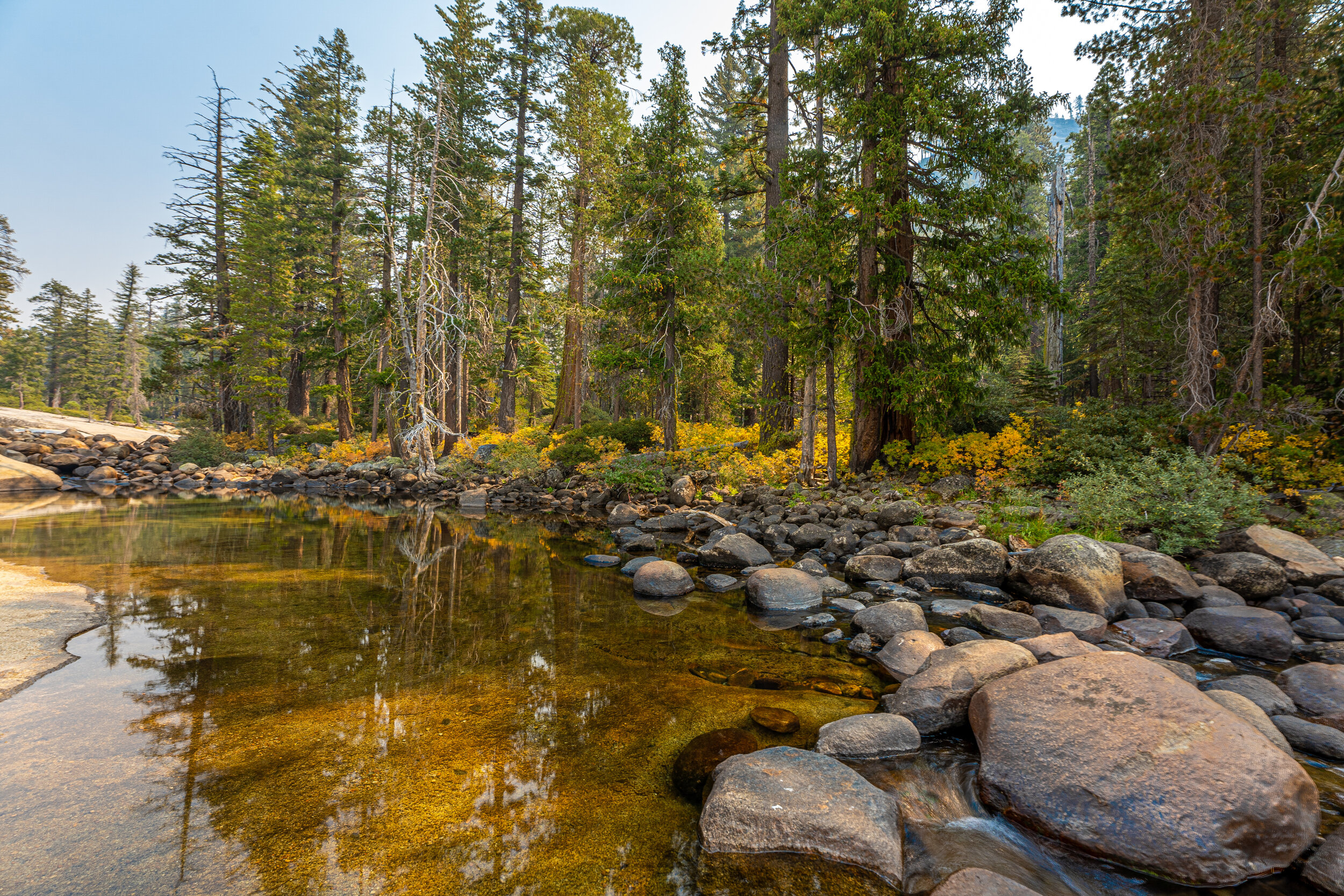
Yosemite NP. If you’ve kept up with us for very long, we know you’ve probably seen enough rocks, streams and trees for a lifetime, but here is another just because it’s beautiful. 😉
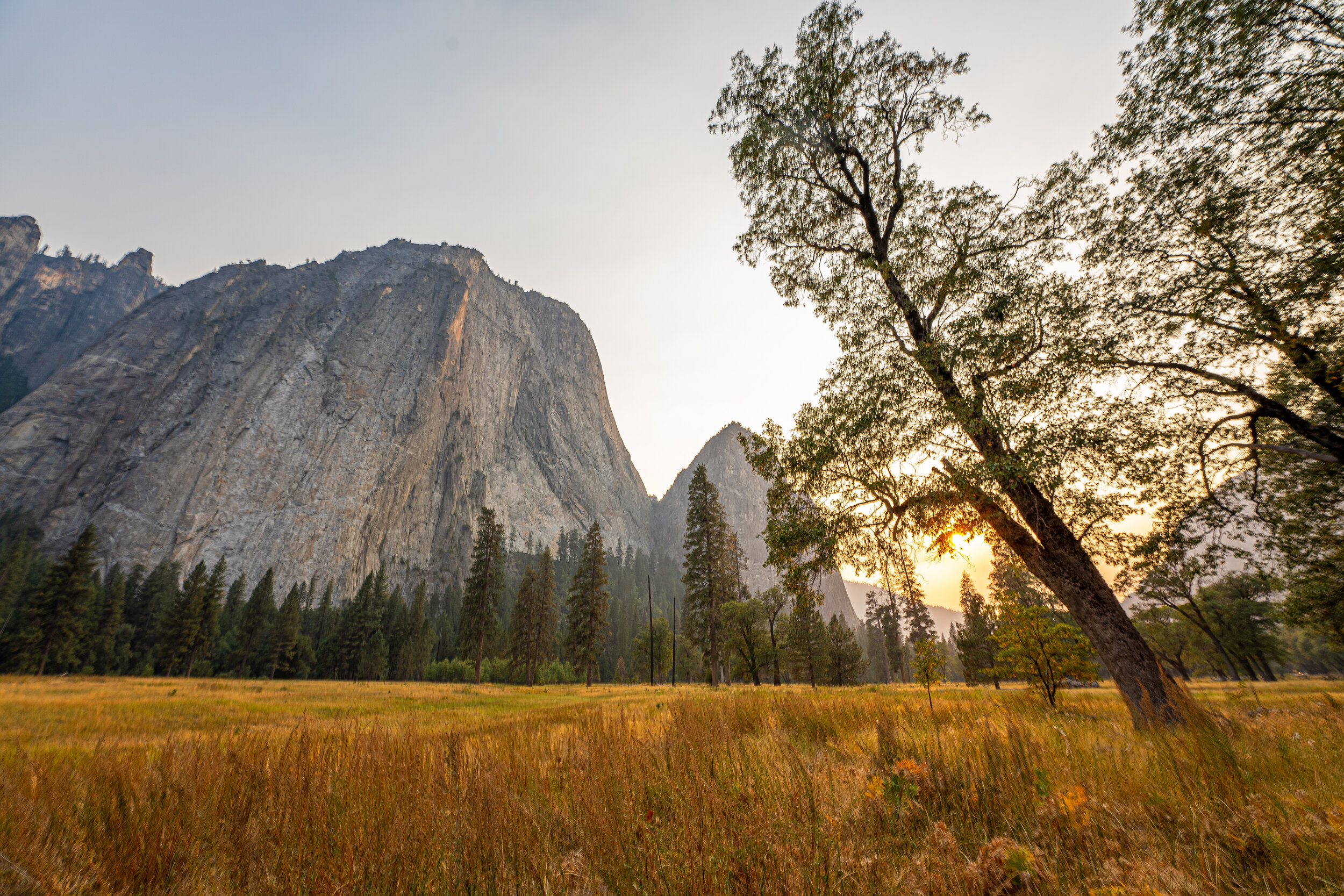
The color of gold that glows here in the evening is unlike any other place.
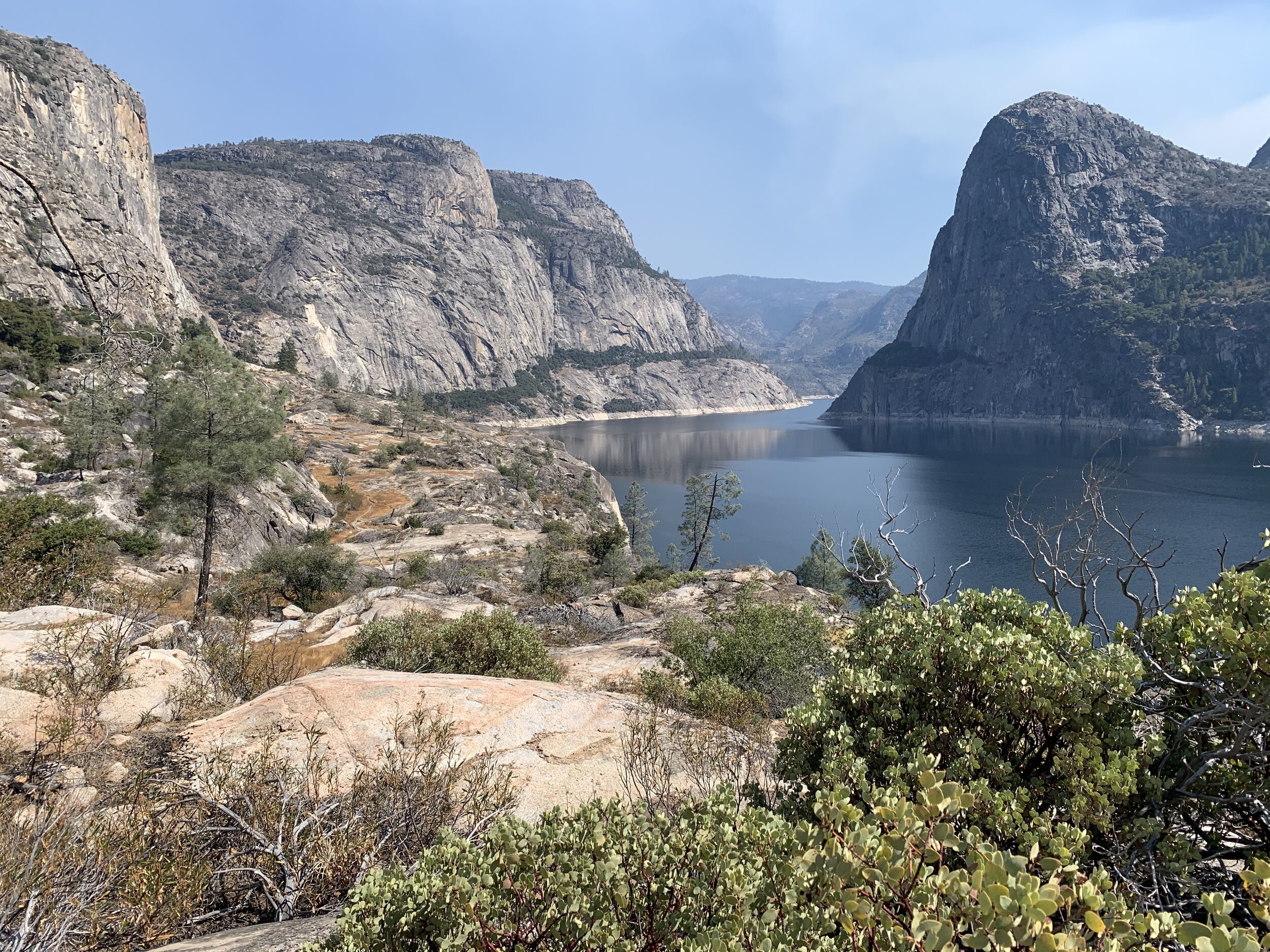
Although equally as beautiful, very few of Yosemite National Park’s visitors take the time or trouble to visit the remote area of the Hetch Hetchy Reservoir. The entrance to this area is miles out of the way and is therefore known to be a calm and quiet place. From where we stood to take this picture, we saw a bear walking towards us on the trail ahead. That was the end of this hike; we turned around and made our way back to the car. That makes two bears in two days. 🐻🐻

Our ability to completely fill a day is elephant-sized! After visiting Hetch Hetchy and Yosemite NP in the same day, we hiked the along the South Fork Tuolumne River outside of the park that evening. It may have been delirium, but I believe I saw a woolly mammoth along the way.
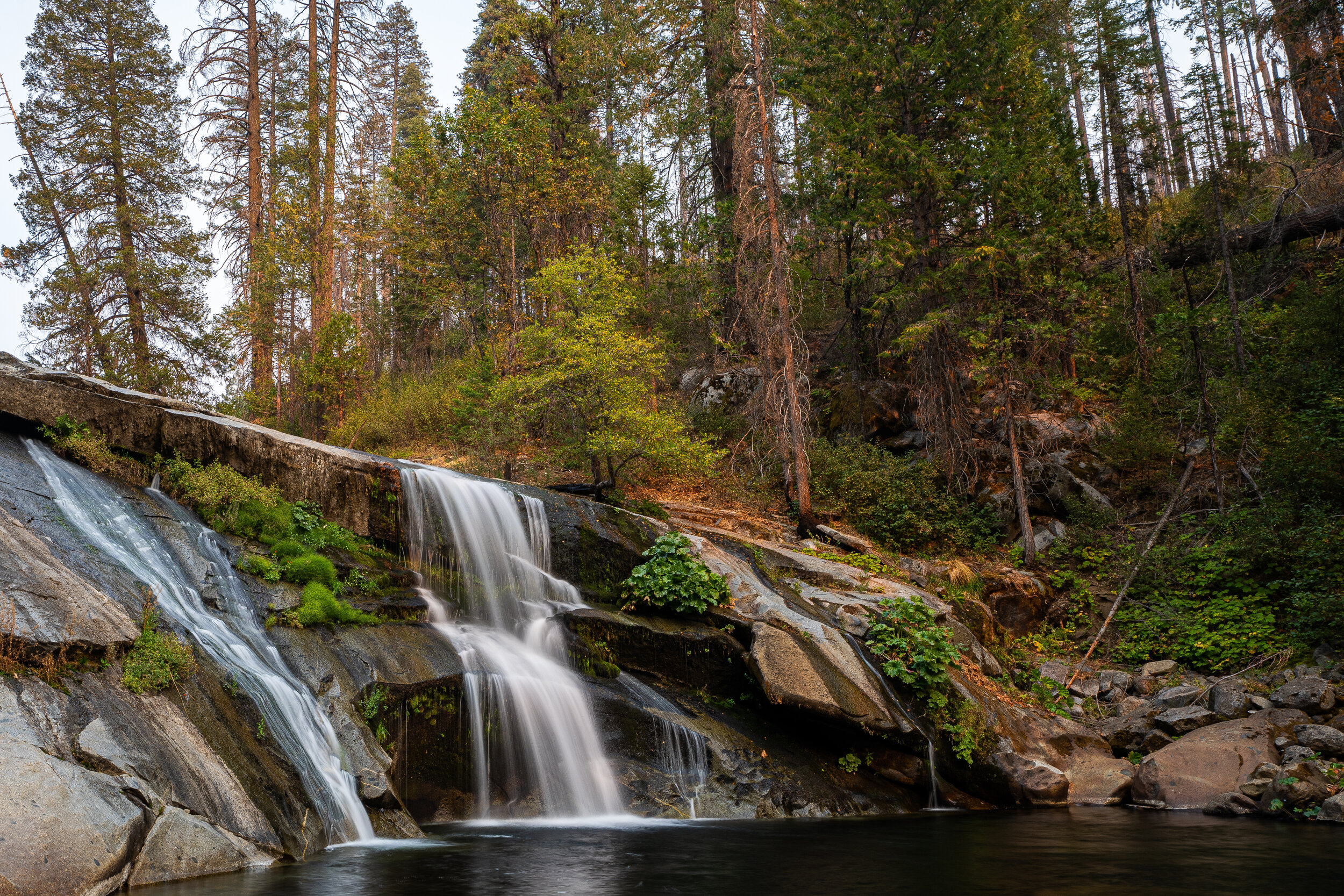
Carlon Falls on the South Fork Tuolumne River.
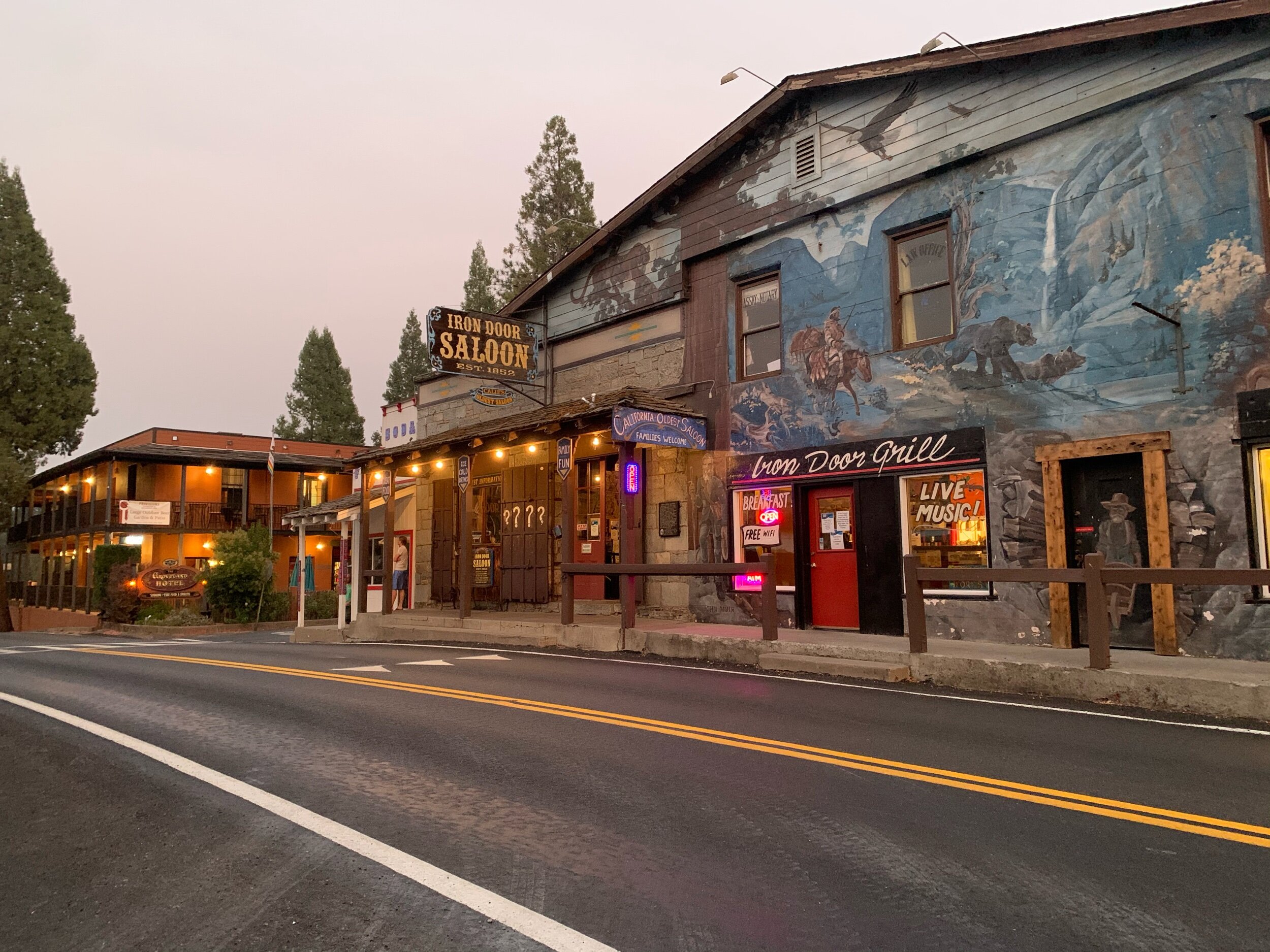
Our RV park was in the small town of Groveland, home of California’s oldest saloon, outside of Yosemite. The saloon has been open since 1852 and still has its original bar intact.
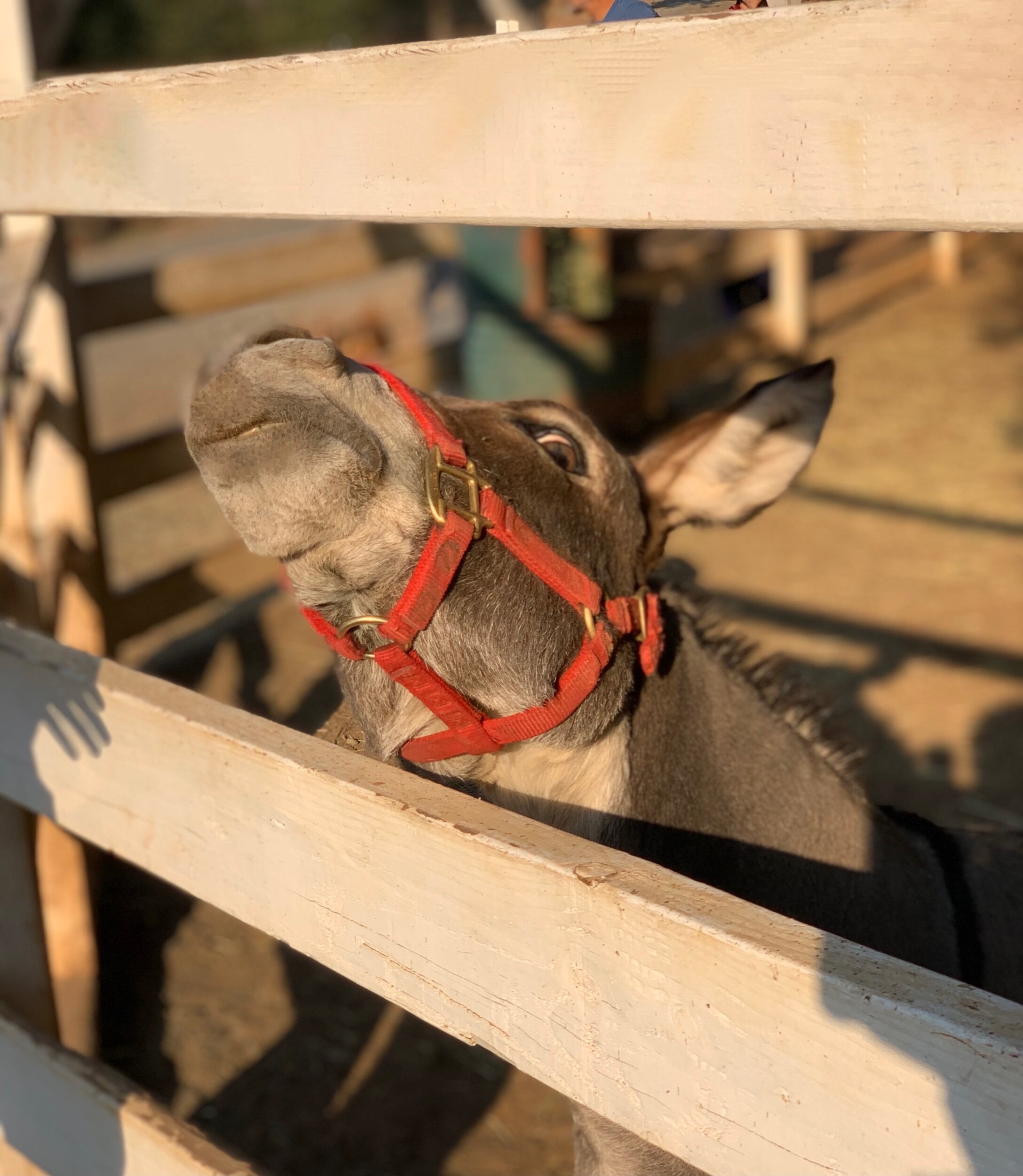
Not much makes me happier than an RV park with a petting zoo. This early morning visit with the donkeys and llamas was our last interaction with life in slow motion before heading off to the big city of San Francisco.
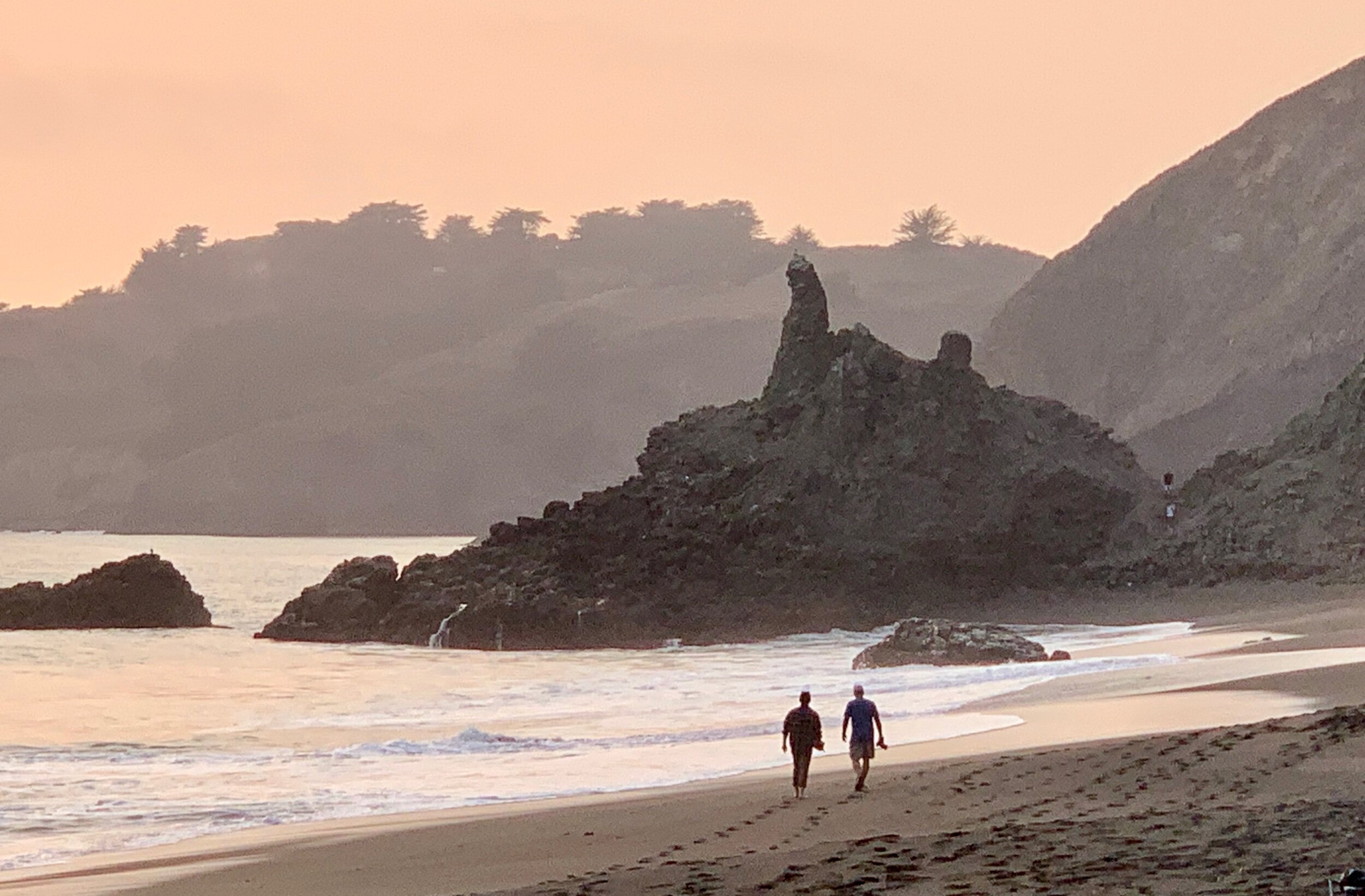
We knew it would happen, but we didn't want it to; time for Chris and Ambrey to go home. Here Craig and Christopher take a beach walk on our last night together.

Point Bonita near Sausalito in San Francisco.
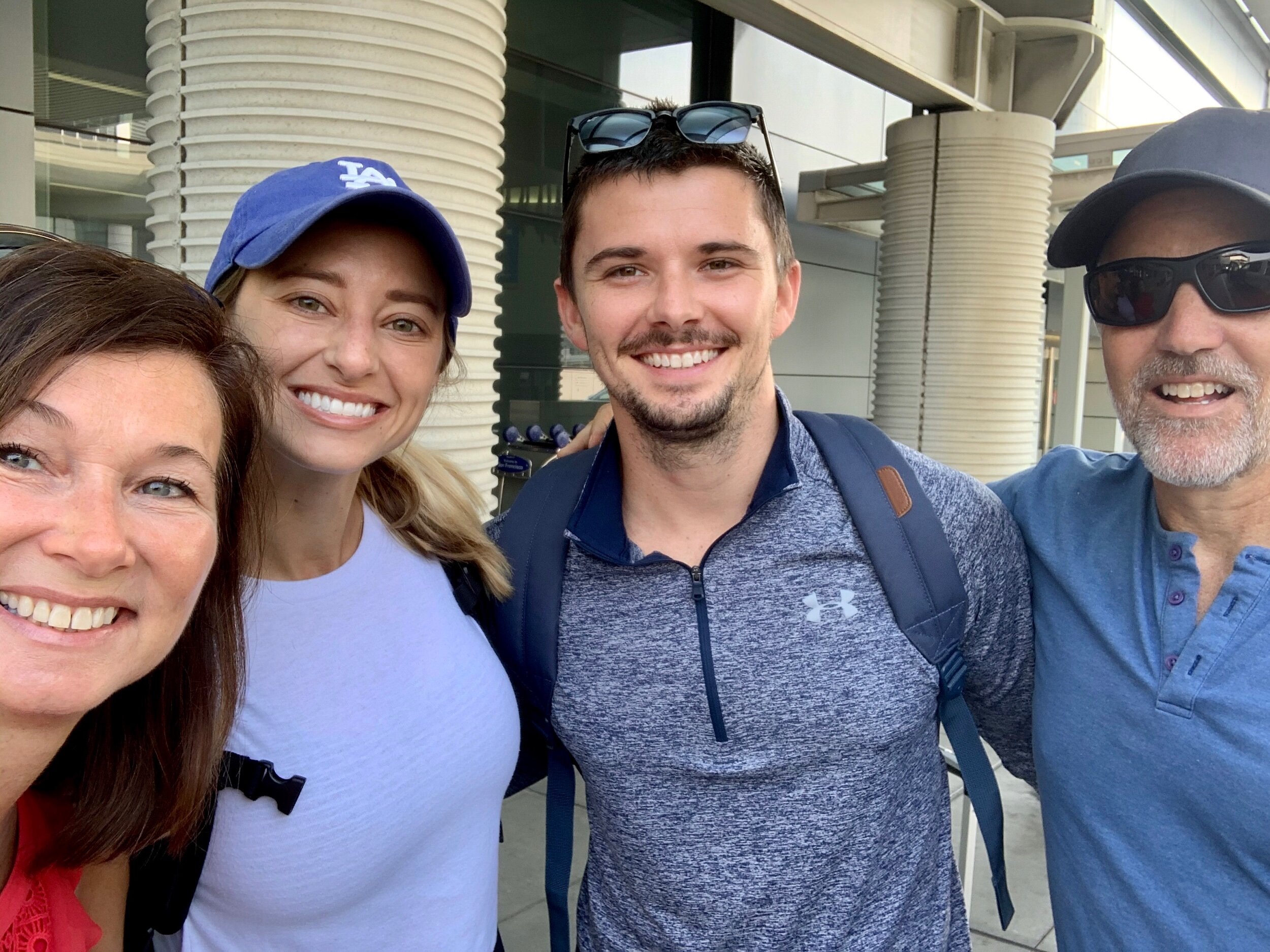
We all had a great time! Tell Atlanta hello for us!
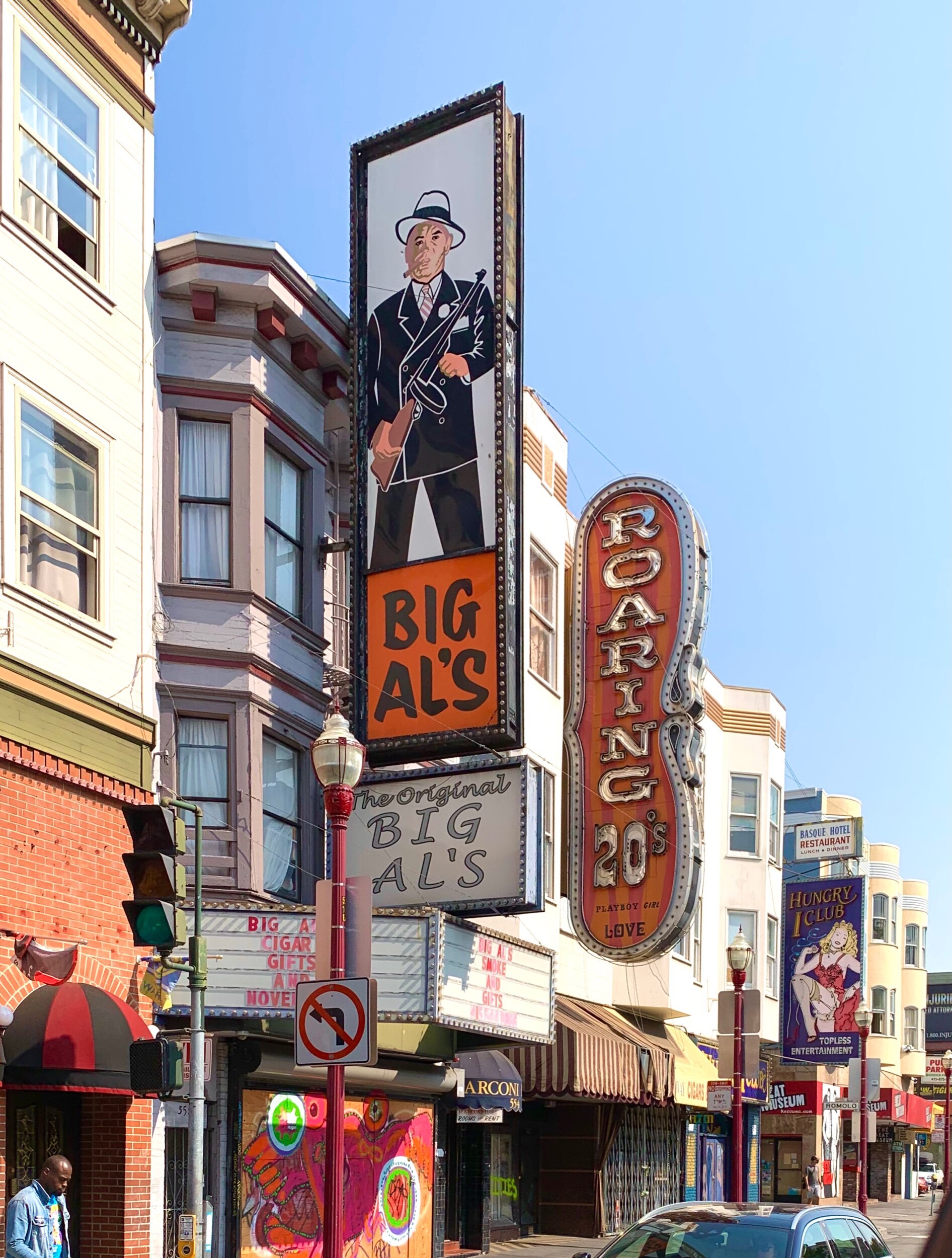
I took this photo because I thought the Big Al’s sign in San Francisco looked antique and nostalgic. I was unaware that the current sandwich shop with the 1960s sign had a far less savory history as an infamous trend-setting strip club. We enjoyed San Francisco for a day, and would have loved going to Alcatraz, but it was still closed.
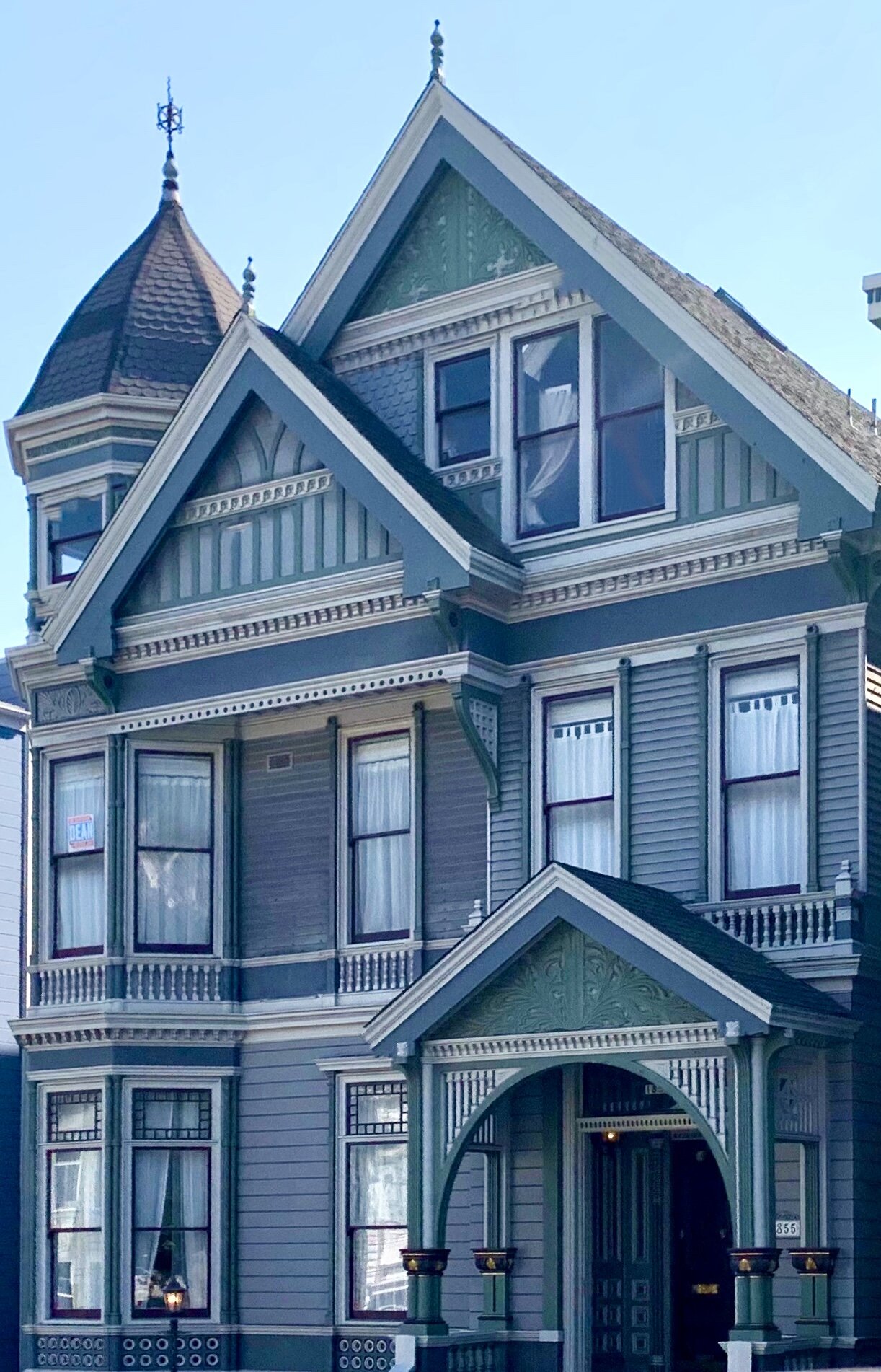
We enjoyed driving all over San Francisco and seeing one if its most lovely features—the uniquely beautiful Victorian and Edwardian homes, built from 1820s until the mid 1900s.

After leaving San Francisco, we headed south down the coast toward Big Sur. Along the way, we saw the Hurst Castle. Forgive us for the terrible picture. That's as close as we got! It also was closed so we didn't get to tour. The Hurst Castle is off of Route 1, in a rural area overlooking the Pacific ocean. Countless rich and famous have traveled that highway for engagements at the castle including Clark Gable, Calvin Coolidge, and Winston Churchill. William Hearst was the ridiculously wealthy man known for developing the nation's largest newspaper chain and media company, and was the inspiration for the famous 1941 movie, Citizen Kane. 🌹
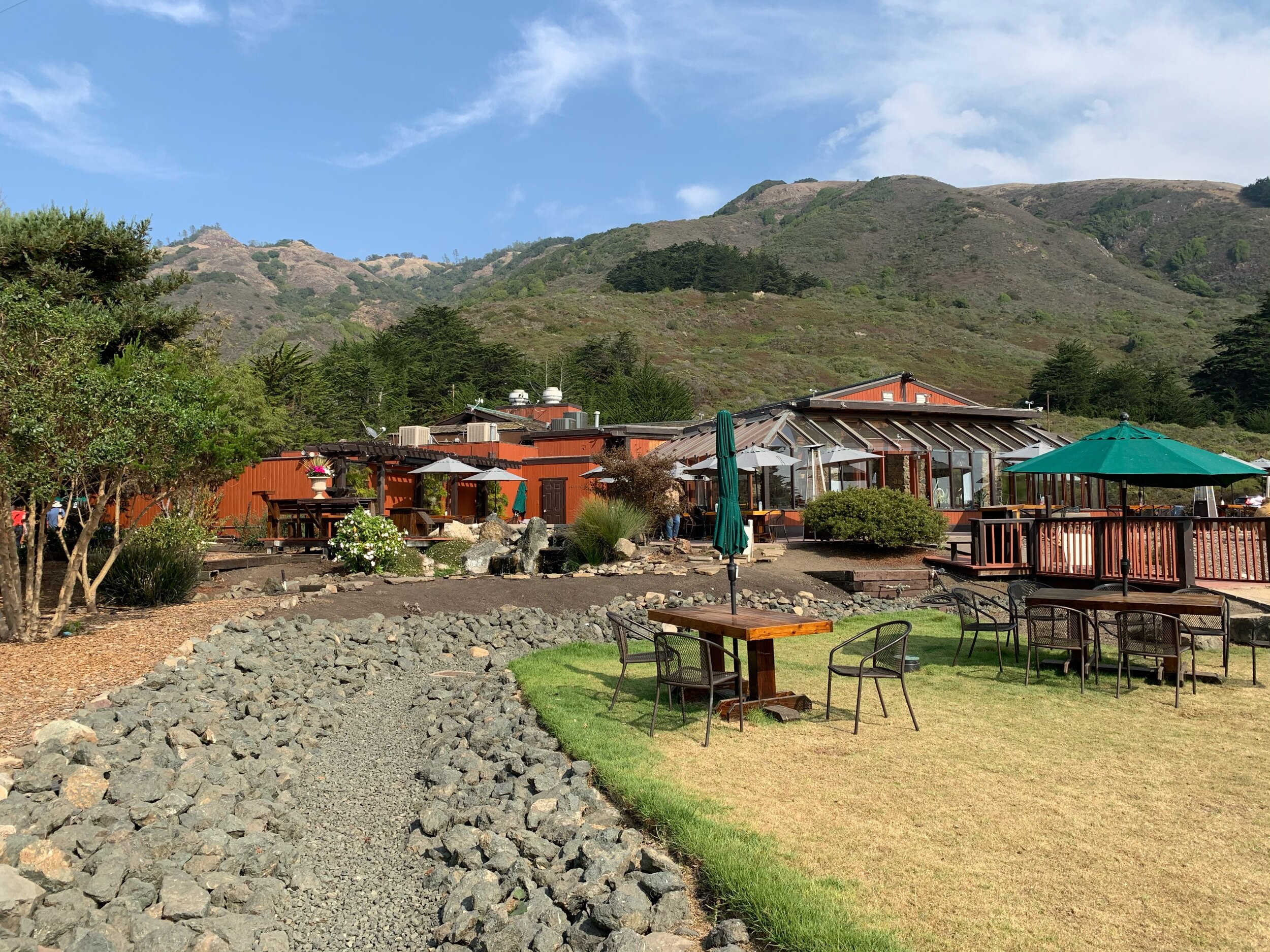
Ragged Point Inn and Resort was built in the 1950s on land that used to be part of the Hurst Ranch. This gem sits high on a cliff overlooking the Pacific. There was a privately owned trail for hiking (at your own risk, of course) down the cliffs to the water. The trail was almost entirely vertical in some places. It was an enjoyable adventure and afterward we had lunch in this serene courtyard.

The trail down to the water at Ragged Point is behind me in this photo, and goes almost straight down over 250 feet to the water’s edge.
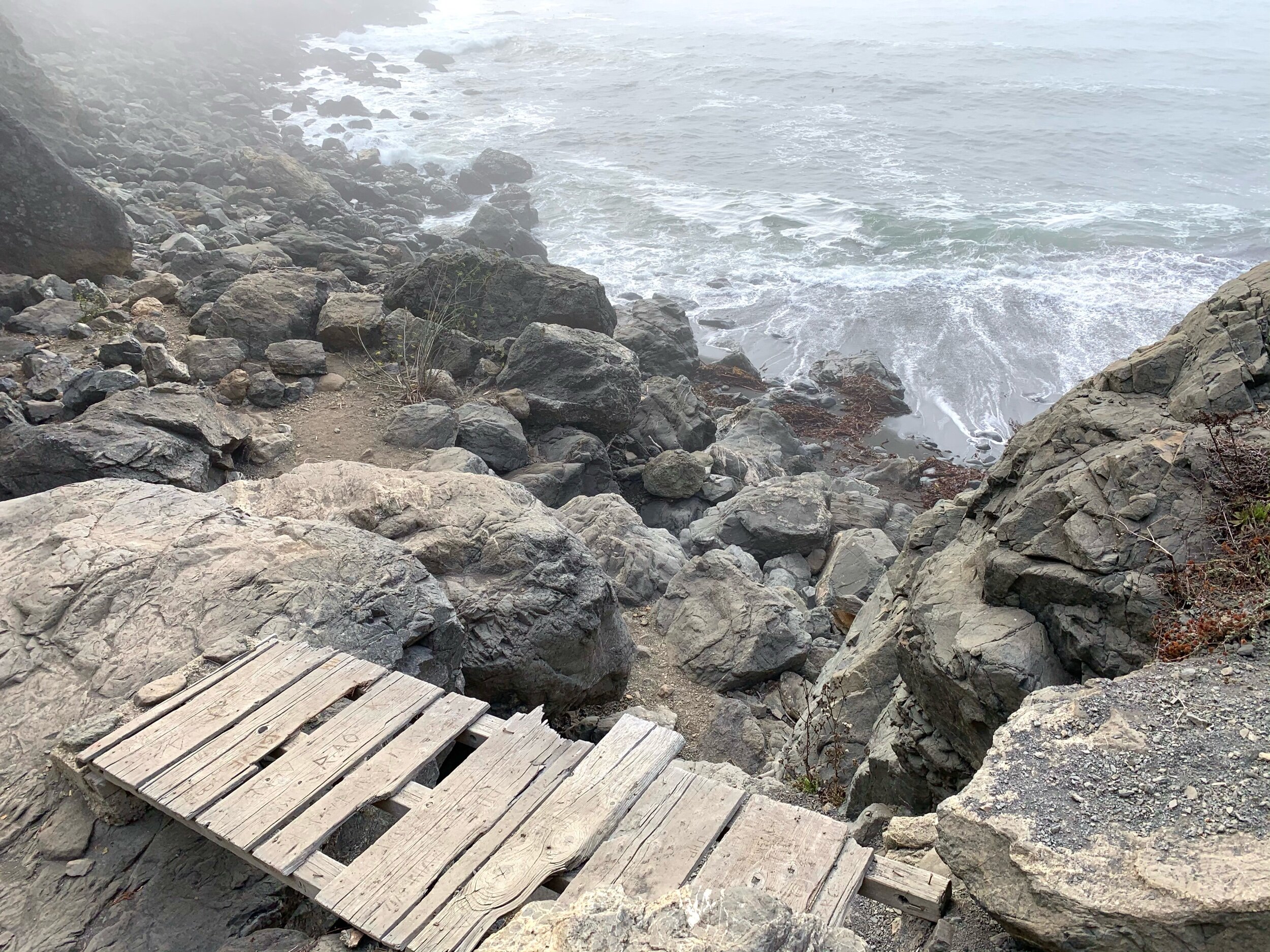
Getting down to the water was difficult, but not as difficult as getting back up…
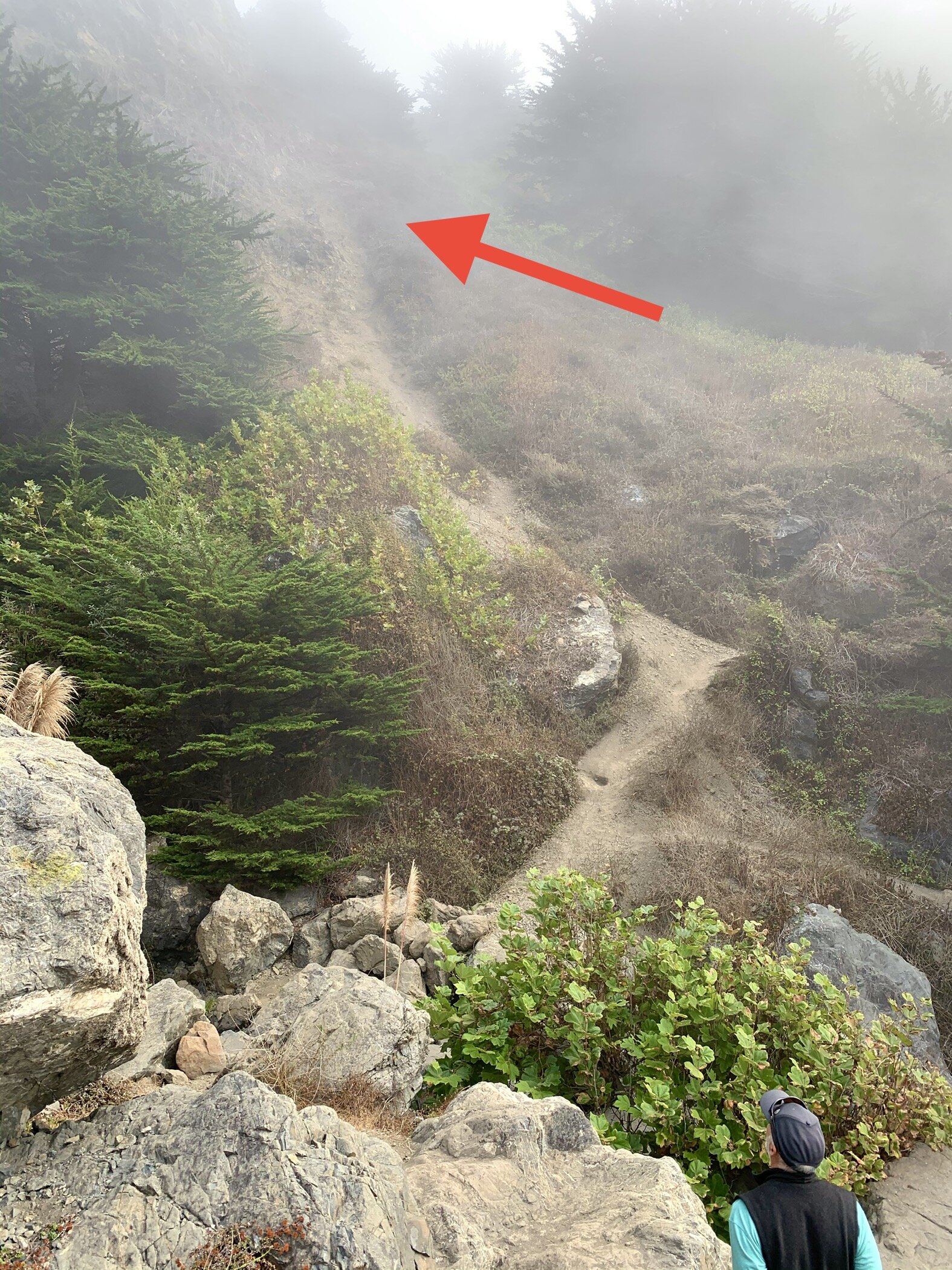
Craig scopes out the trail heading back up.
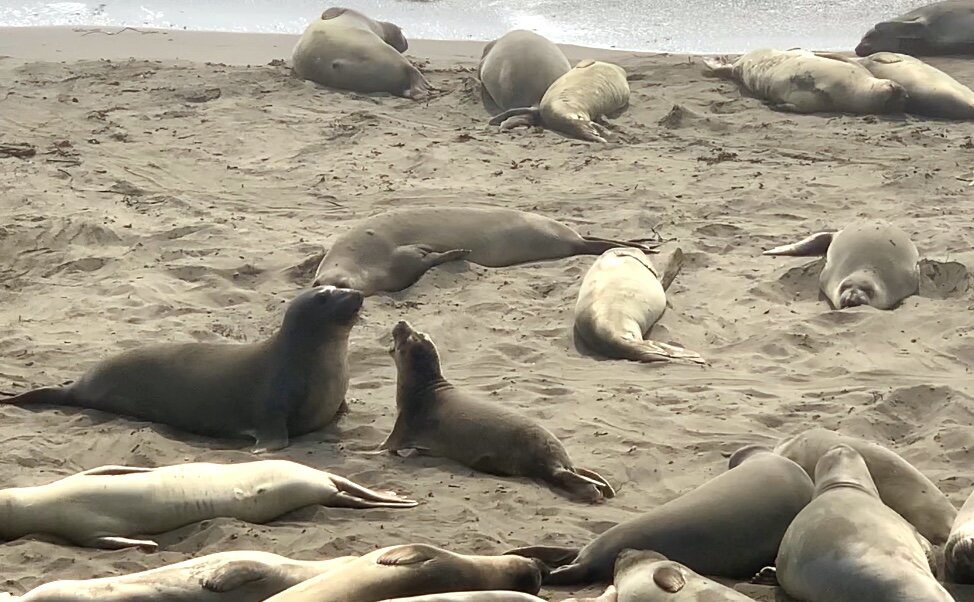
Up to 17,000 elephant seals can be seen along the Hearst-San Simeon State Park coastline during birthing and breeding season in November-January. These jumbo seals have a fascinating schedule all year long. During our visit, it was "Fall Haul-Out" season; the males and females who are too young to take part in the breeding season stay here and rest, and the males practice fighting for breeding rights for when they are older. We witnessed their casual fighting and their attempts to rest--often, they wake up to scratch themselves or throw sand on their bodies to cool and protect themselves from the sun.
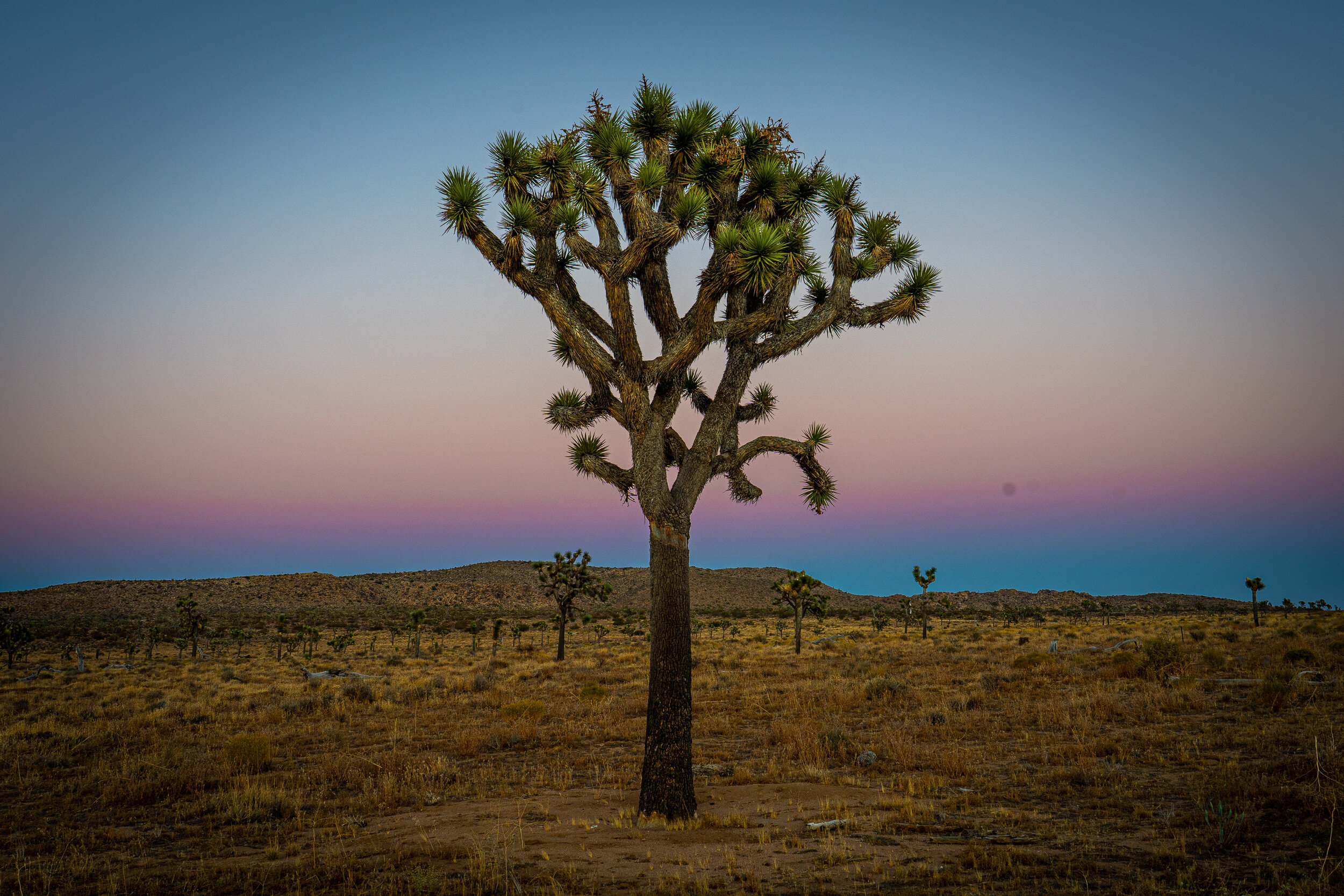
The Joshua trees of Joshua Tree National Park are in the Mojave desert. Joshua Tree NP is unusual in its varied animal and plant life because this is where the two separate ecosystems of the Mojave and Colorado deserts come together.

Joshua trees were named so by early Mormon settlers because they look as though all arms are stretching to heaven, as referenced in a story in the Bible. Joshua, Moses’ successor, succeeded in battle as long as Moses’ hands were raised toward God.
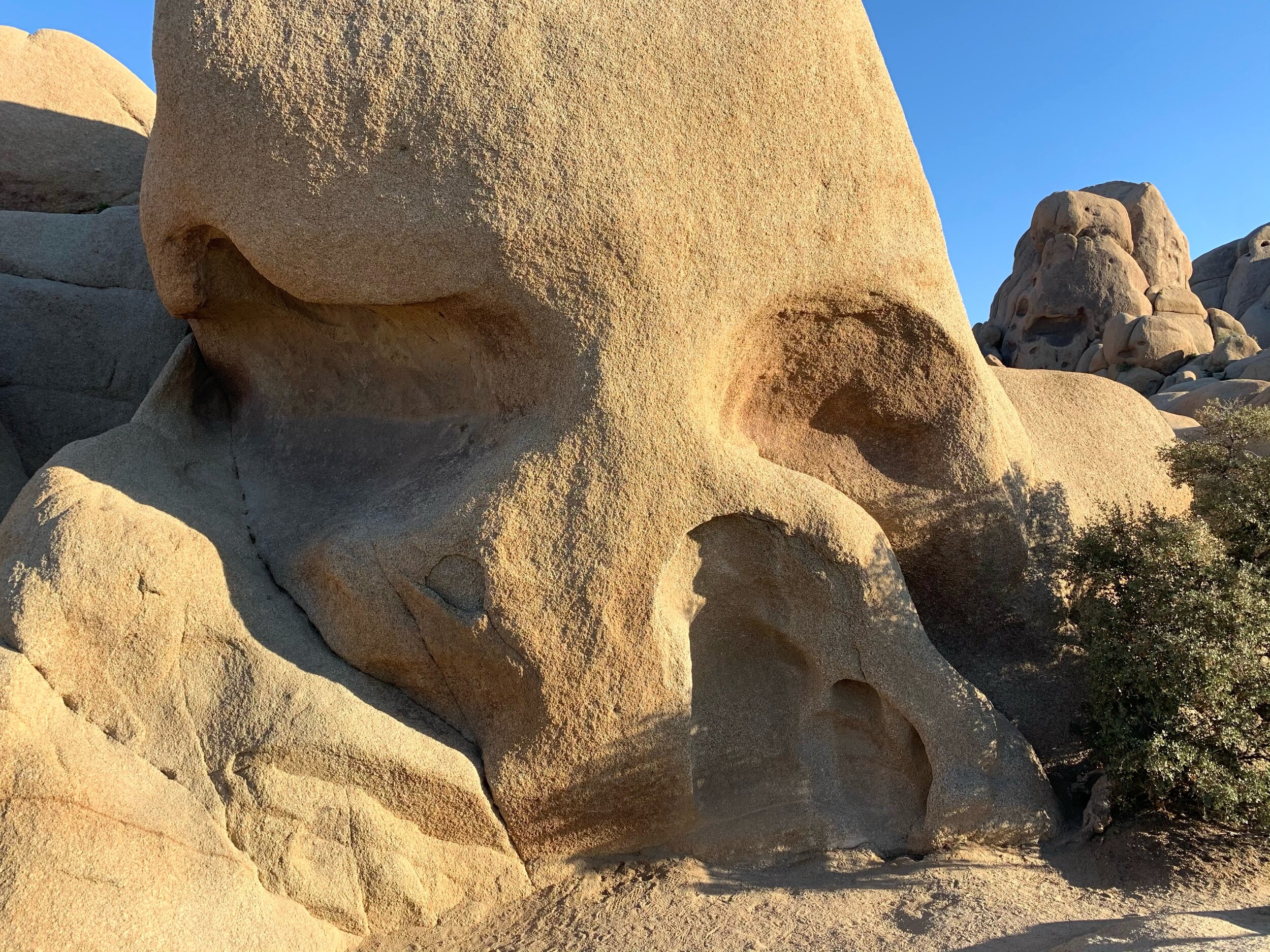
Skull Rock is a popular attraction at Joshua Tree.
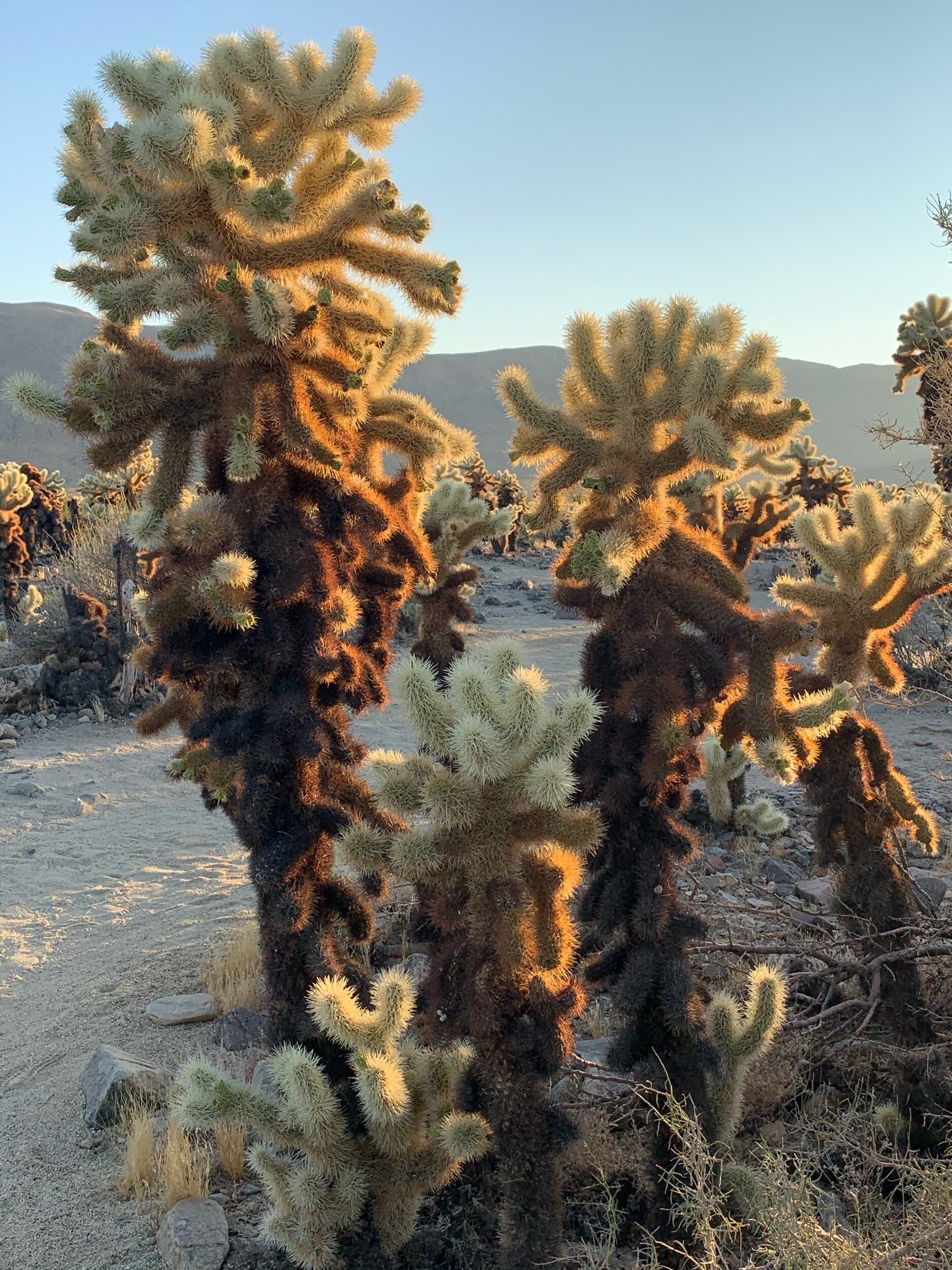
The Teddy Bear Cholla cacti in Joshua Tree NP are unusual and beautiful.
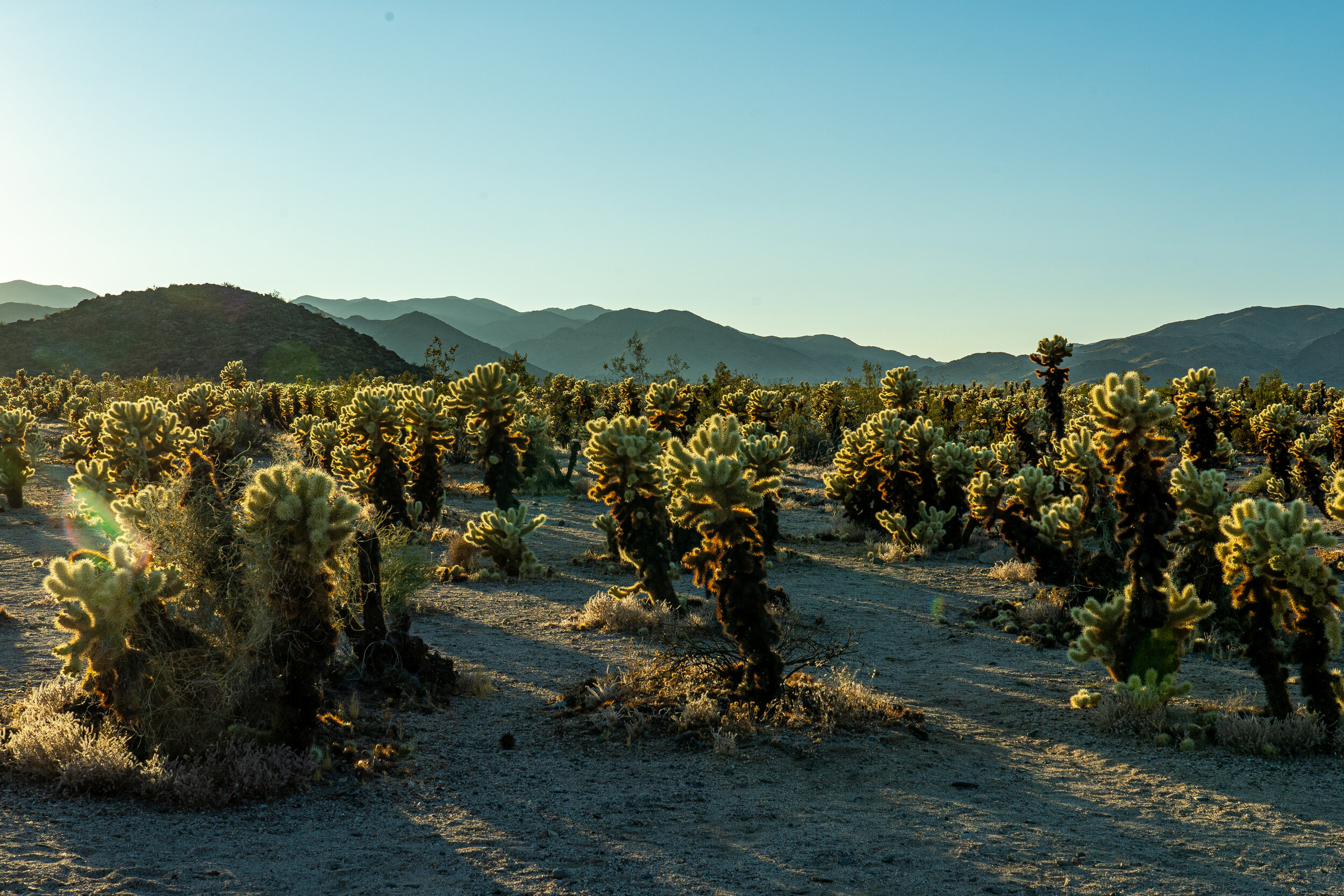
The Cholla Cactus Garden was a fun, 1/3 mile loop full of prickly Teddy Bears.
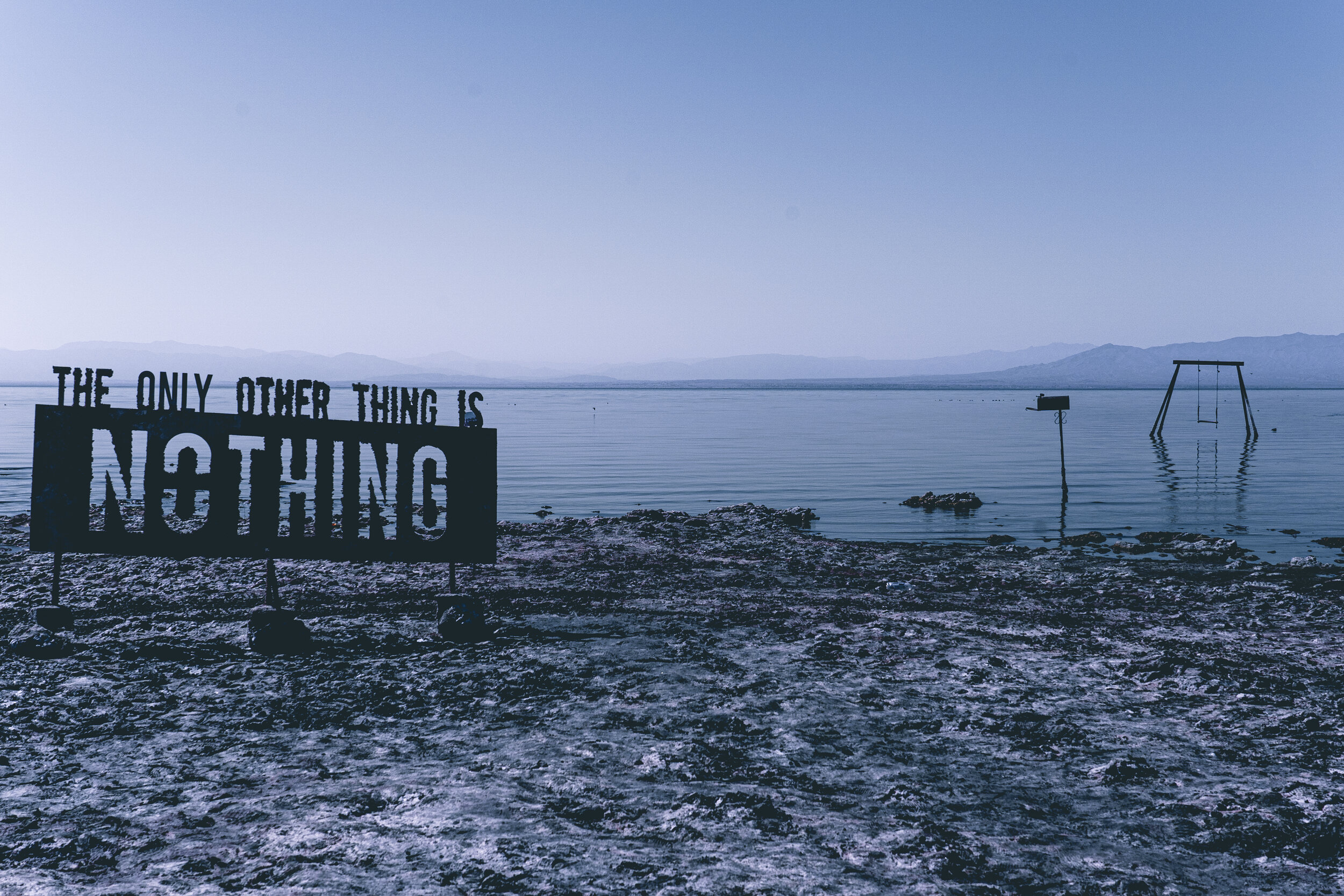
Now for the obscure: This is Salton Sea, and it's actually a lake. Last year, Palm Springs Life referred to it as "the biggest environmental disaster in California history." Here's our best condensed version: In 1905, farmers altered the flow of the Colorado River for crop irrigation, and a series of subsequent events caused excess water to turn dry land into what became the state's second-largest lake. The Salton Sea became a bustling upscale vacation paradise, and the area exploded with hotels and vacation homes in the 50s and 60s. In the 70s, scientists said the lake was shrinking, getting saltier, and would adversely affect the rich bird and fish population. No one cared. Accidental contamination from farm chemicals caused an outbreak of diseases in the water in the 80s and killed most of the fish and, eventually, birds. The increasing saltiness of the lake later finished off the bigger fish. With millions of dead fish carcasses on the beach and the stench of rotting wildlife in the air, tourism died too, and a thirty-year exodus ensued, leaving this area deserted and desolate.
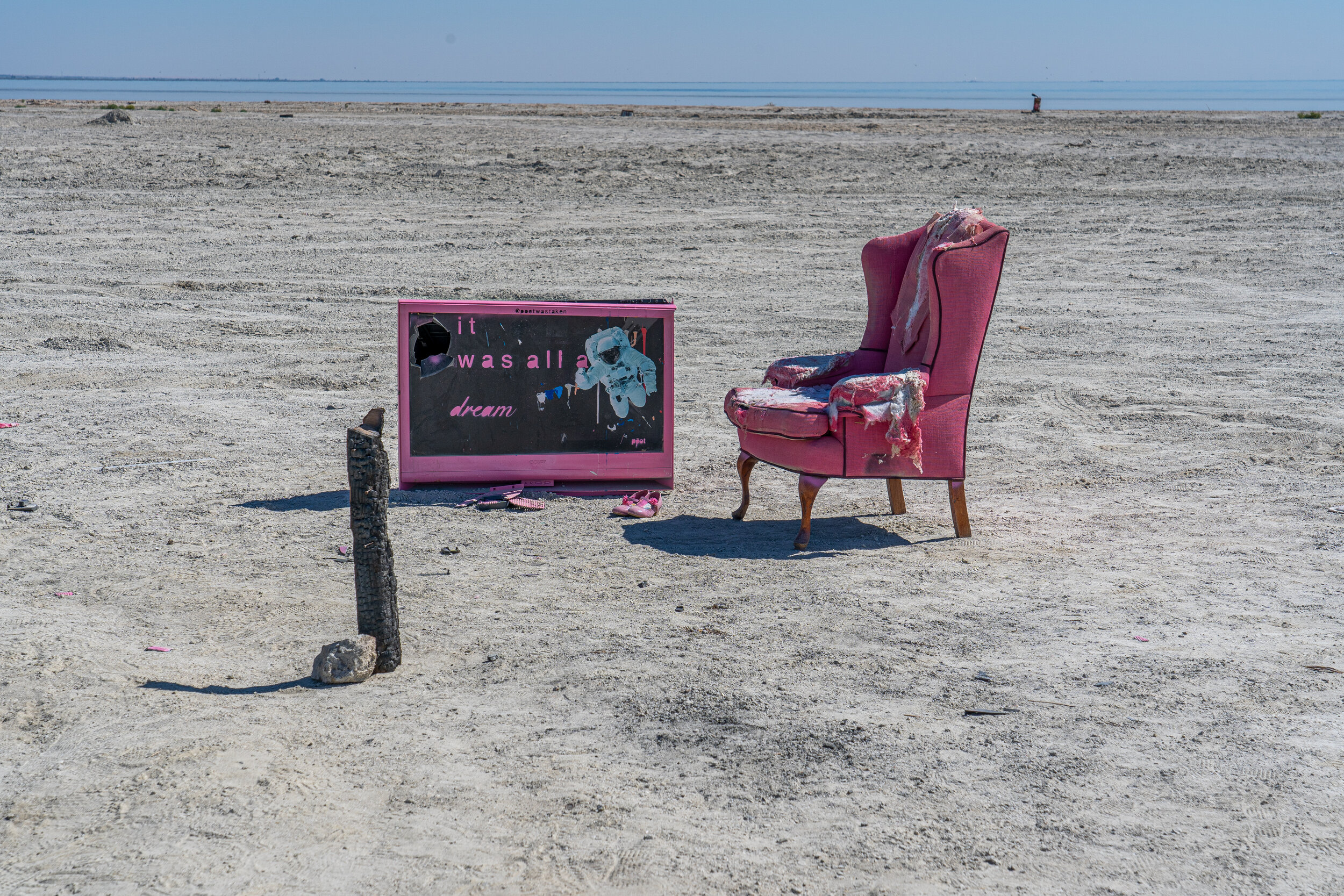
As everything died in the Salton Sea, the once sought after land became a liability to businesses and homeowners. Vacation homes were abandoned, vandalized, and left to crumble. A flood years ago dispersed the contents of the abandoned houses, giving the area an even more apocalyptic ambiance. Today, the area is well known for its most unusual circumstances and has become a canvas for eclectic artists that often use the debris as part of their art, as seen here on Bombay Beach.
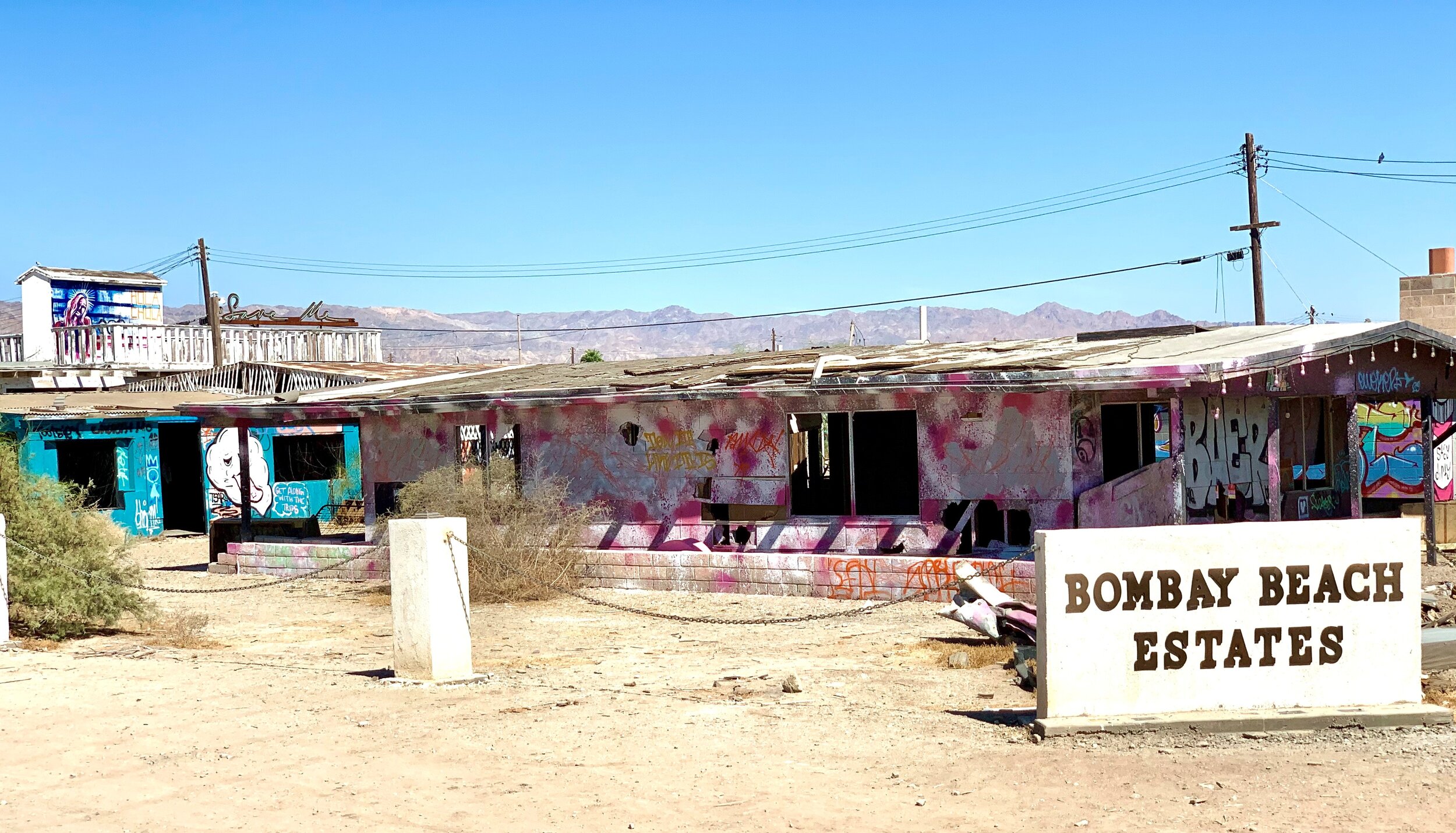
In its heyday, Bing Crosby and The Beach Boys entertained here, but in recent years Salton Sea’s only notable celebrity visit was from Anthony Bourdain, who featured the area on Parts Unknown. And by the way, it still smells terrible here. One vlogger said of the Salton Sea, “If California needed an enema, this is where you would put the tube.”
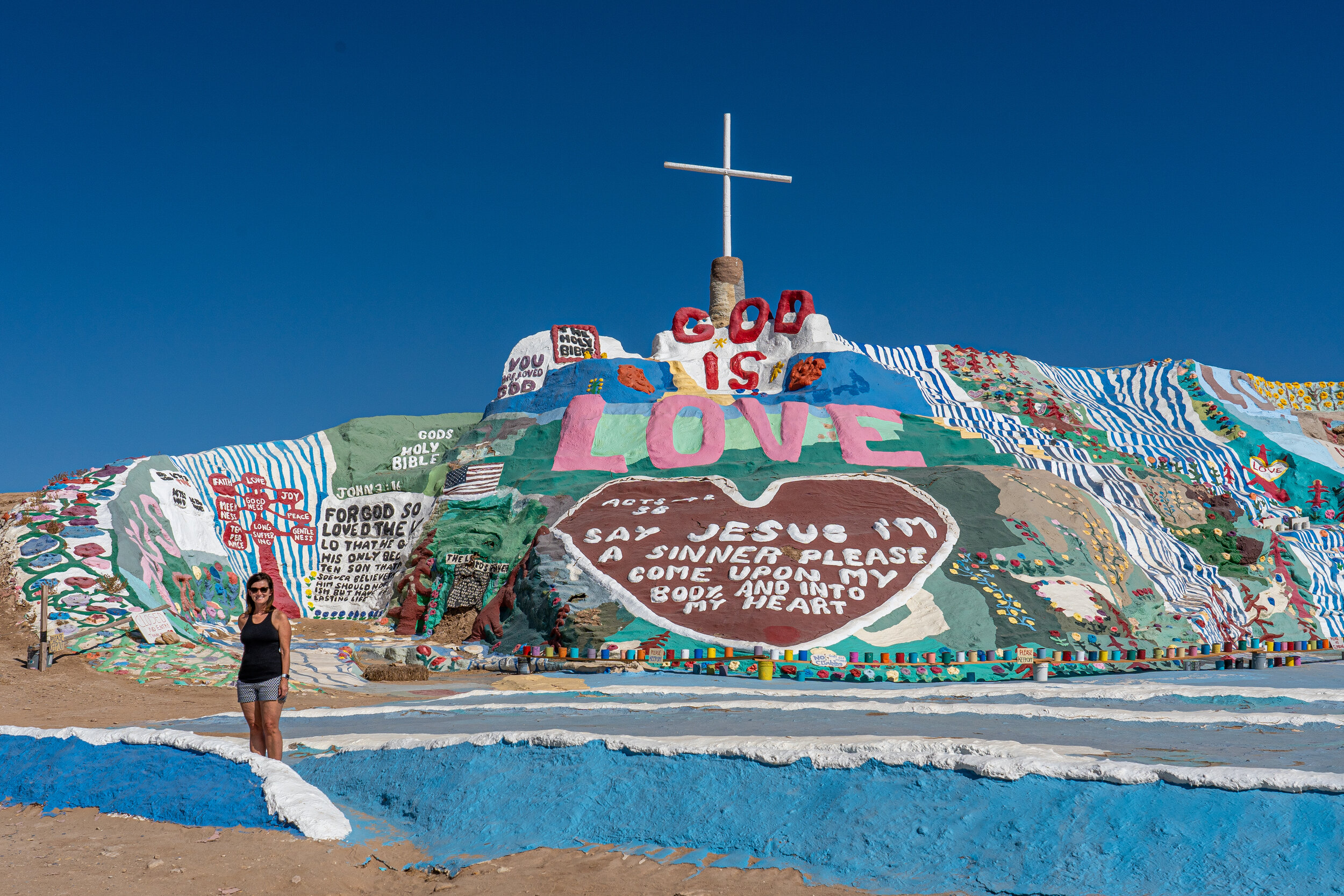
One person described Salvation Mountain as "Candy Land meets Vacation Bible School." This mound of mud, hay, and over a million gallons of donated paint was a 28-year long project of Leonard Knight, the man who settled here and began to work on his dream. Before he passed away in 2014, he made a video giving a tour of the entire place and gave his reason for this project: "I wanted to put "God is Love" in a beautiful and simple way to everybody. God loves everybody in the world, and I love everybody too."
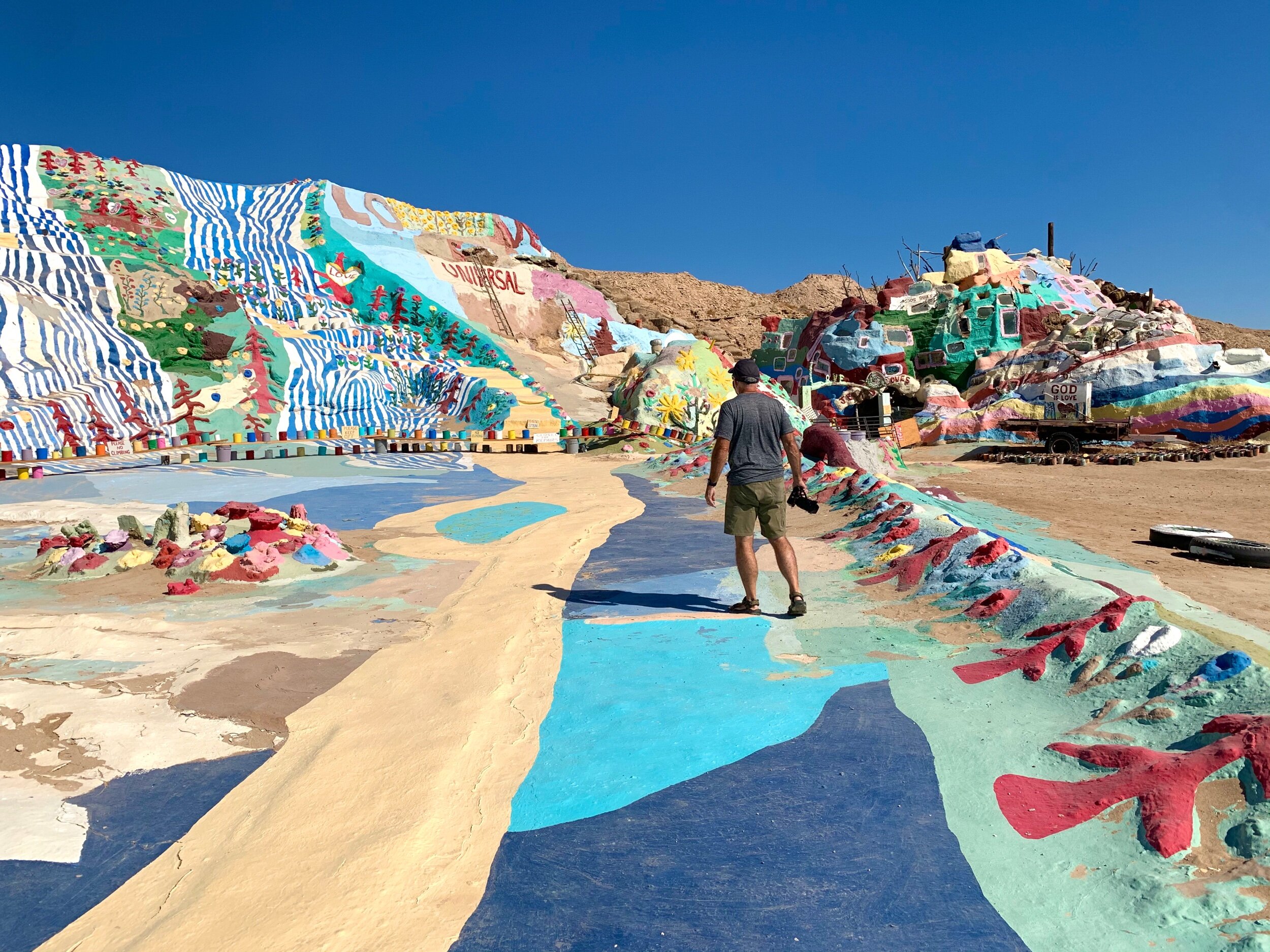
The blob on the hill on the right is Mr. Knight’s museum for touring. There are also cars, boats, buses, and other decorated things sitting around. In the video, Knight was especially proud of his yellow brick road and the two waterfalls on the left.
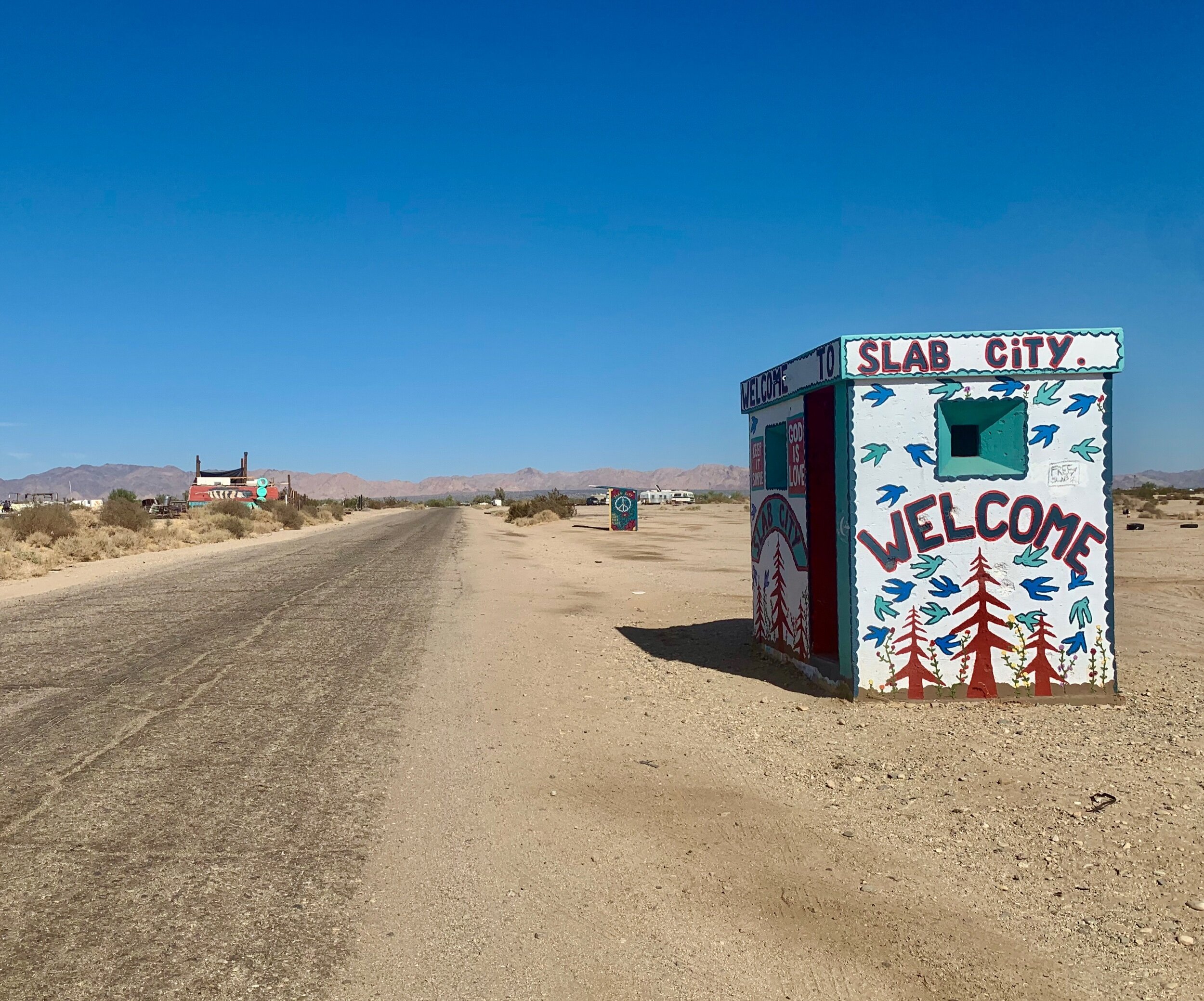
If you thought the last two places were odd, you haven't seen anything yet. Meet Slab City, “The Last Free Place.”
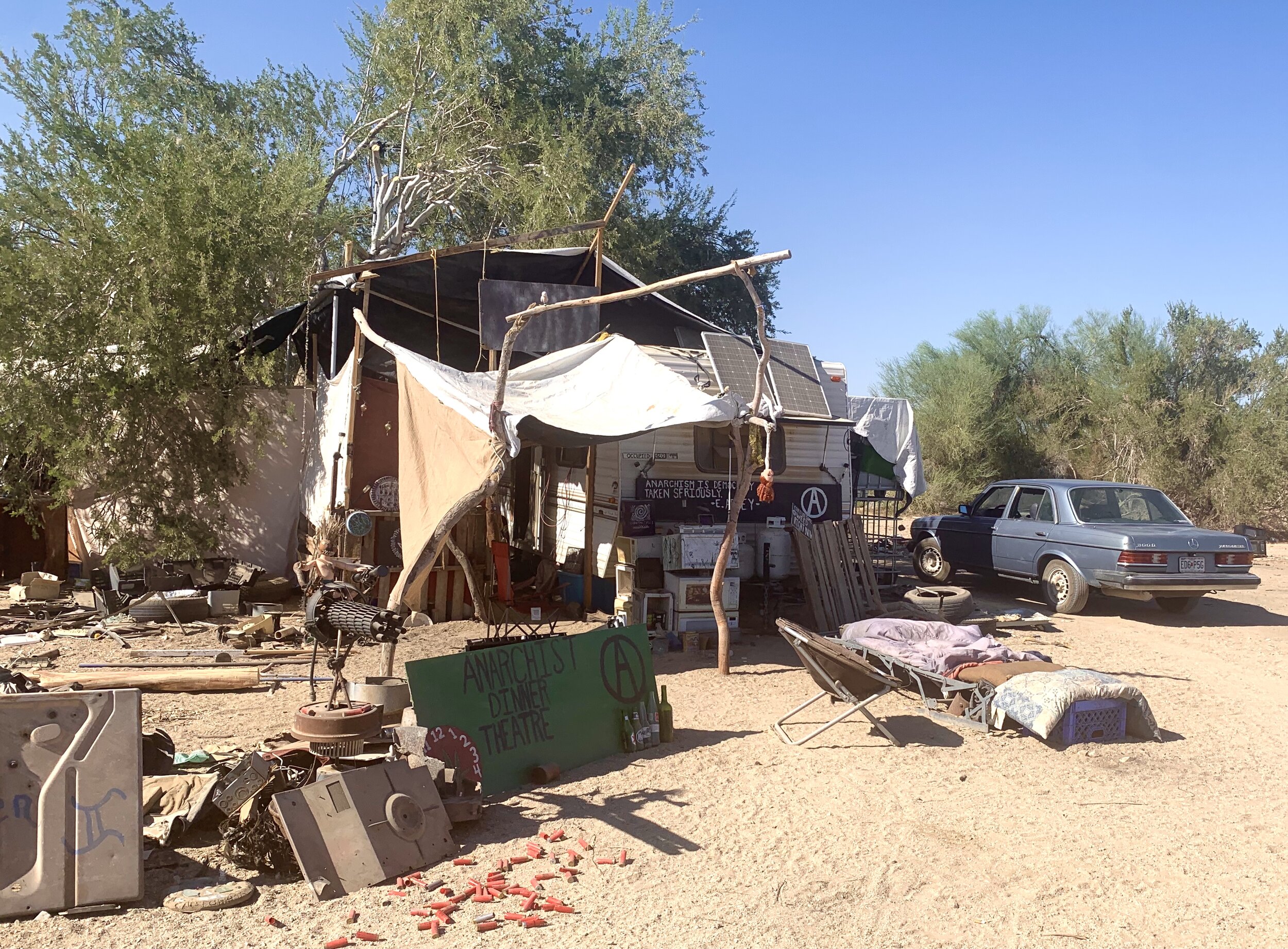
Wikipedia describes Slab City as an off-the-grid squatter community known for attracting people who want to live outside mainstream society. There is much to say to explain this bizarre community, and at the same time, there are no words. The quote on the front of this camper says, "Anarchism is democracy taken seriously." Another sign advertises the Anarchists Dinner Theater. And yes, those are shotgun shells on the ground.

The first "slabbers" were Marine veterans who never left when the WWII Marine base here closed and dismantled--leaving only concrete slabs. The Department of Defense deeded the land to California, and the state never did anything with it, so the veterans stayed. There is no power, plumbing, phone lines, law enforcement, stores, or medical care. In the summer, when temperatures get upward of 120 degrees, there are only about 150 residents, but snowbirds come in their RVs in the winter, and the population gets up to a few thousand.
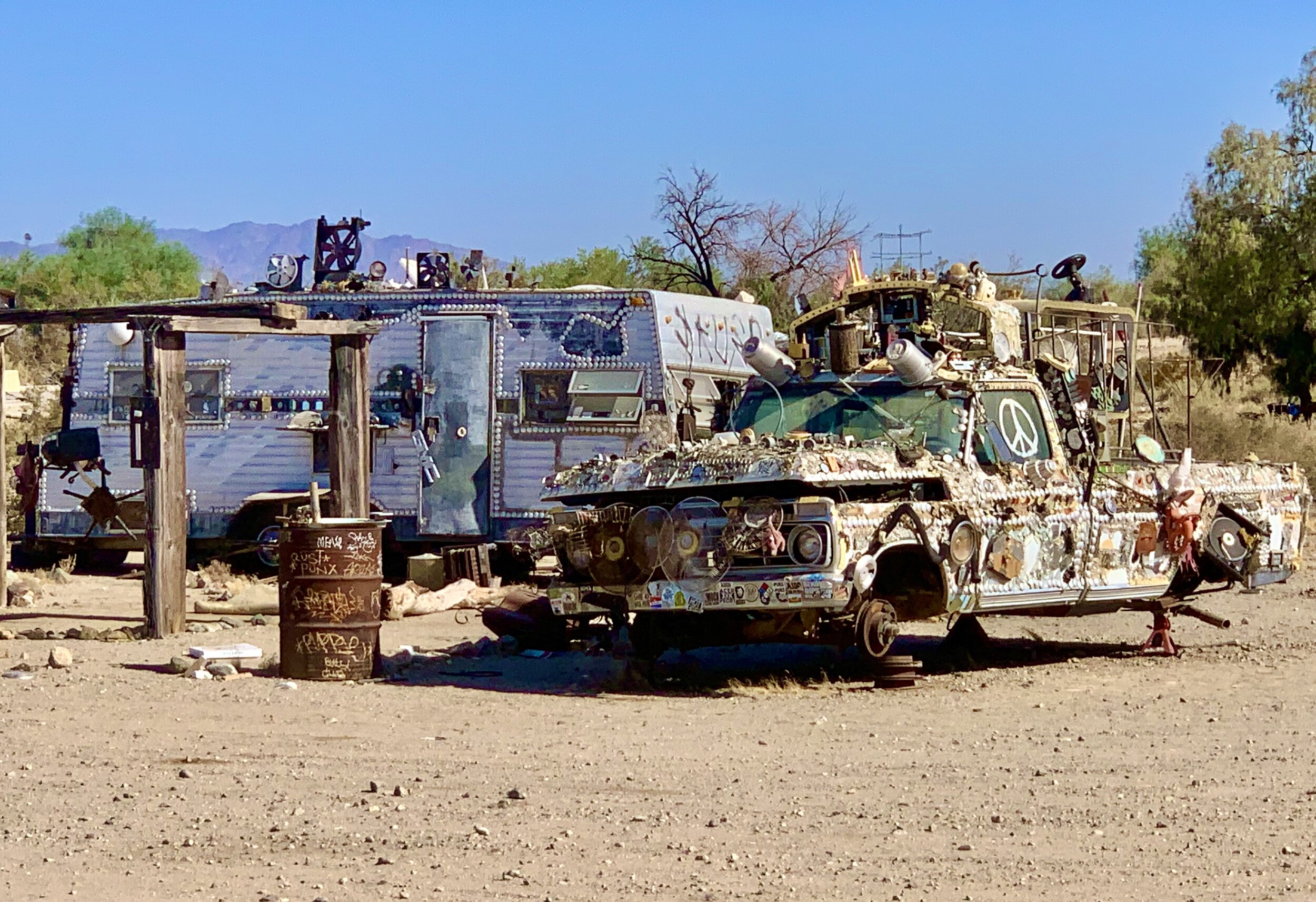
Anarchists, artists, drug addicts, eccentrics, outcasts, outlaws, and retirees have long been attracted to the "free" land as well. Crystal meth and drug abuse have a significant presence here, and as with any city or neighborhood, some have fancier dwellings than others. (This is a fancy one in case you’re confused.)
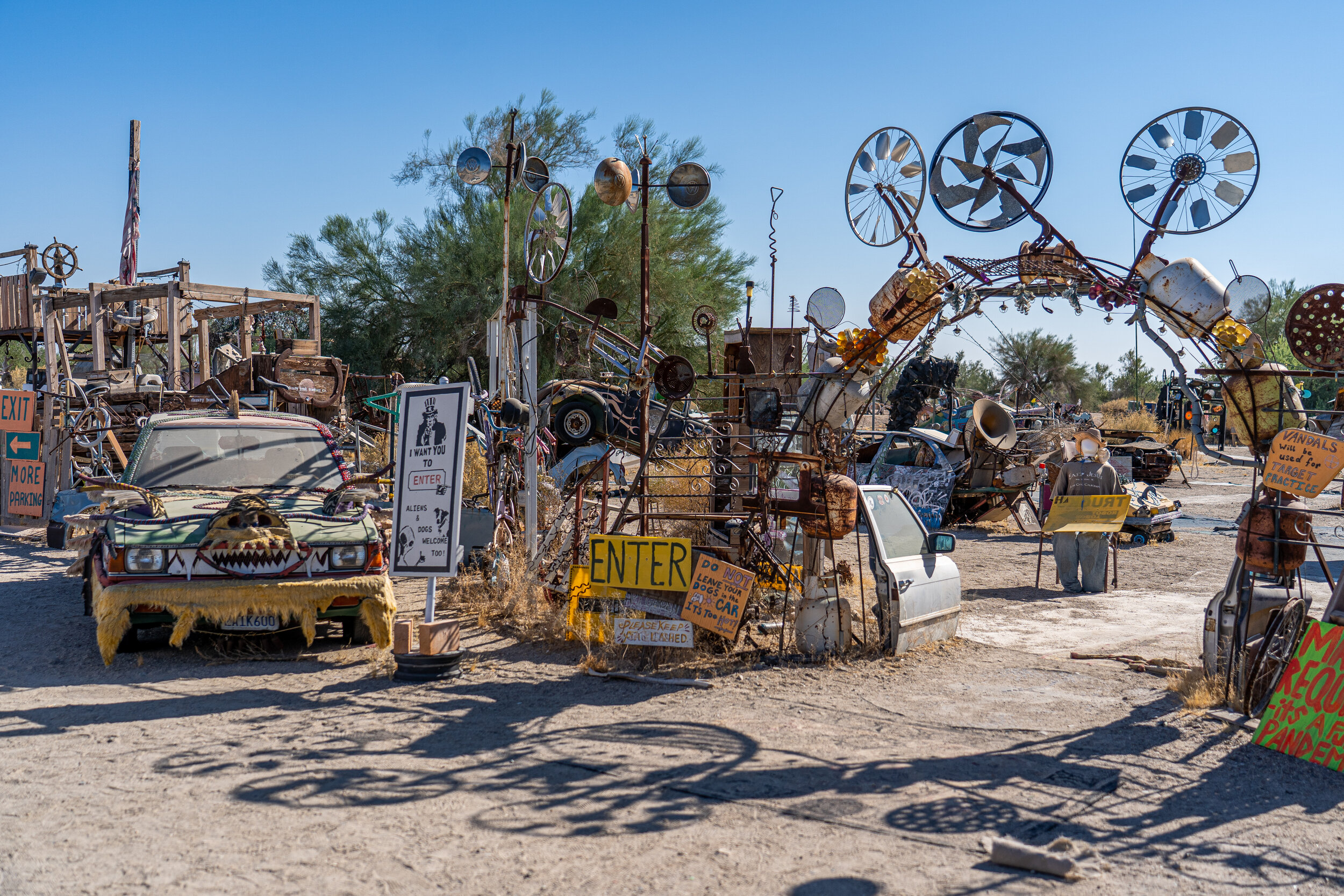
East Jesus is at the very end of Slab City. My best explanation is that it’s a place where artists live and create random things with random things. Their humorous yet sophisticated website explains it in a little more detail: The inhabitants provide a refuge for artists, musicians, survivalists, writers, scientists, laymen, and other wandering geniuses…dedicated to providing an improbable, improvised community at the edge of the world. We have many more pictures, but if you’re remotely interested, there are more great pictures on their website, and the rules for visiting them are quite entertaining. www.EastJesus.org
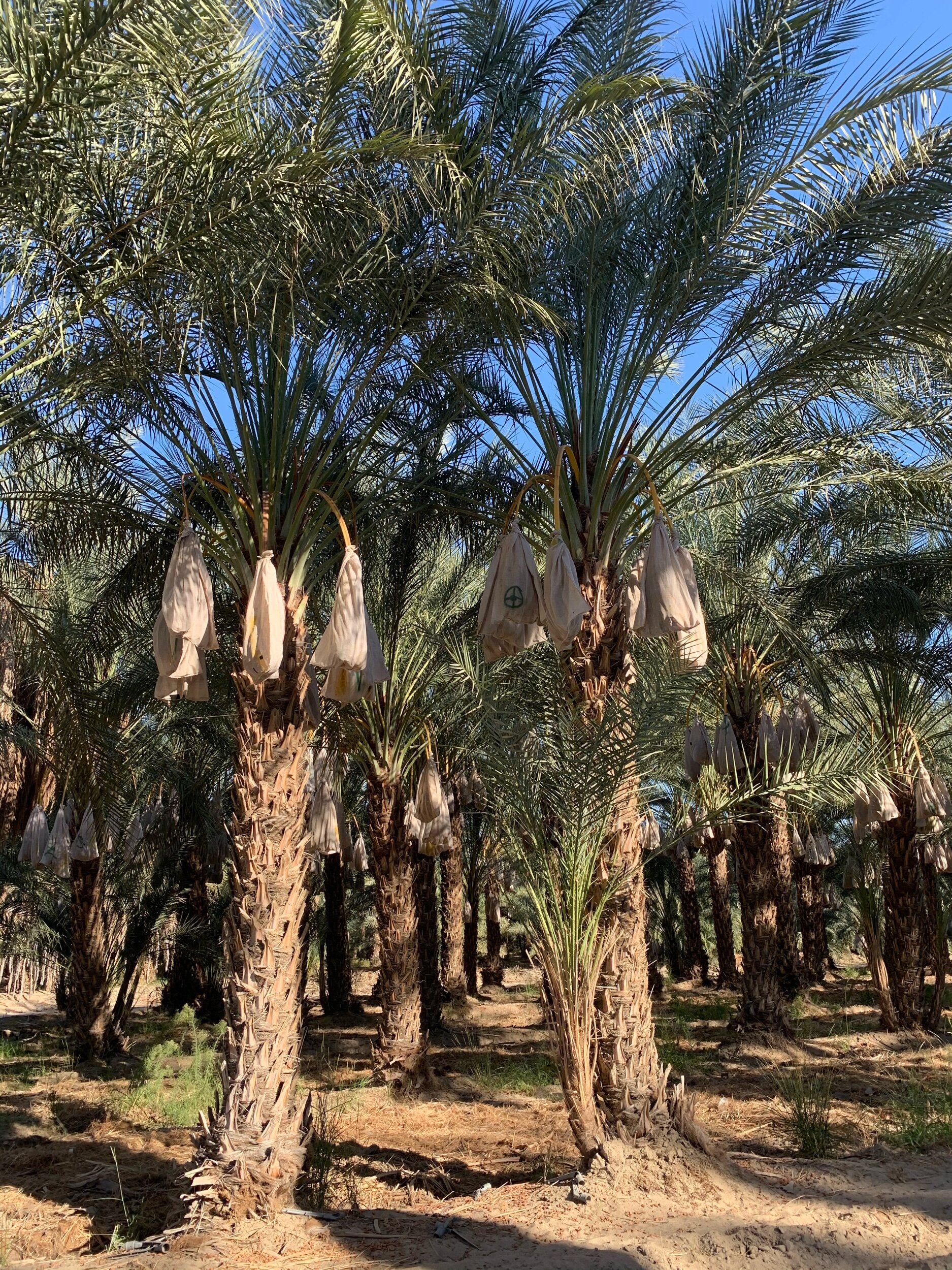
Did you know dates are one of the most labor-intensive and expensive crops to grow? With no significant natural pollinators, female date palms are hand-pollinated from the male palms by humans. The roots need tons of water, but the palms have to be protected from rain. Harvesting is done when the temps are around 100 degrees, and you have to climb 30 to 50+ feet to reach the fruit! The bags shown here are to keep the fruit from being eaten by birds. These farms south of Palm Springs supply 95% of dates consumed in the US.

Did you know that when London Bridge was falling down, an American tycoon bought it and shipped it to his community in Arizona? Developer and founder of Lake Havasu City, Robert McCulloch, struggled to attract tourists and homebuyers to Lake Havasu, primarily due to the remote desert location. Someone told McCulloch the London Bridge—yes, the real one in London —was for sale, and suggested the historical piece may be precisely what he needed to ignite tourism to Lake Havasu. McCulloch decided to take a chance and purchased the bridge for just under 2.5 million. The bridge was delivered to the Arizona desert and installed over dry land.
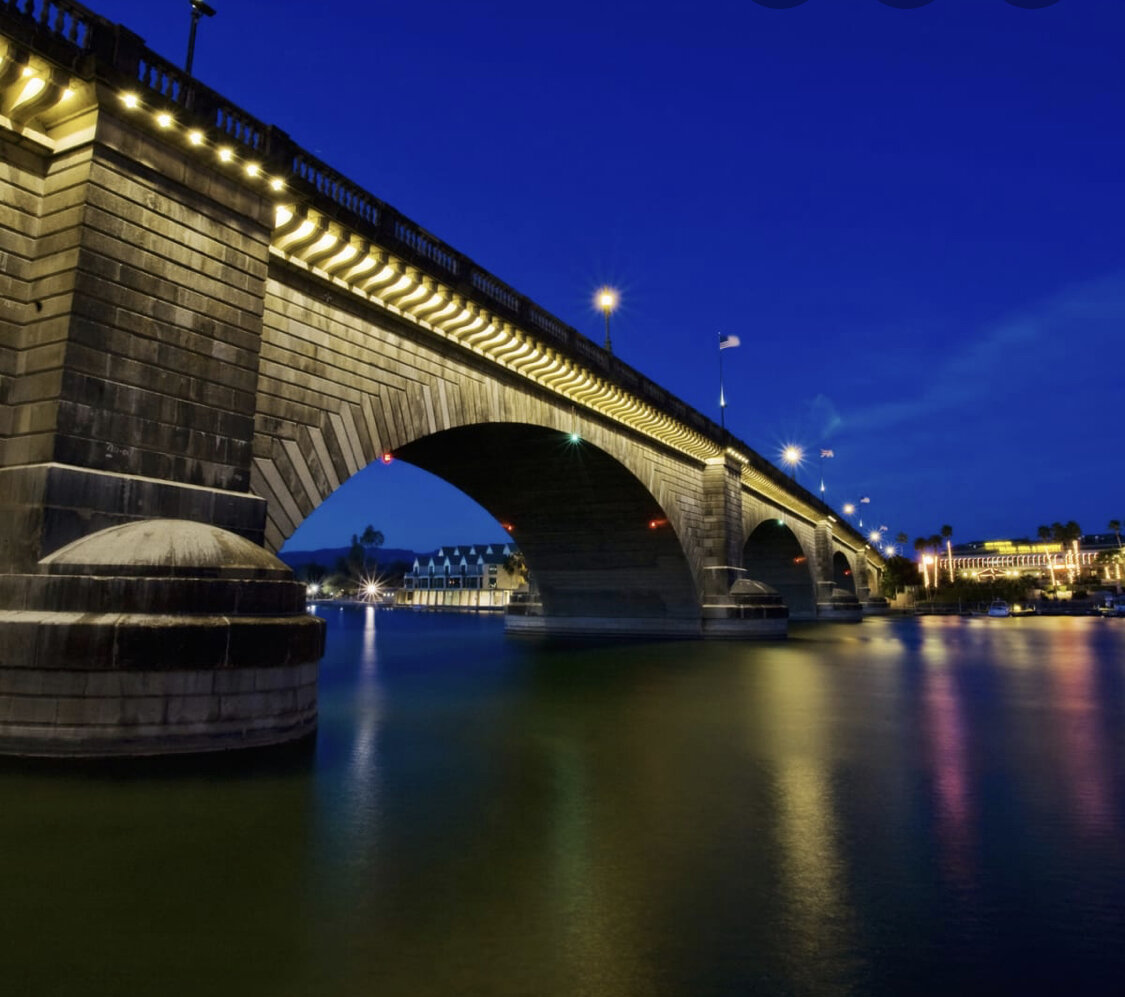
After assembly, engineers dug a London Bridge-sized channel to route water under the bridge for the full effect. In 1971, the bridge was dedicated in Lake Havasu City with a large British-American celebration. Lake Havasu is now a mecca for water and ATV recreation and is the second most-visited tourist attraction in Arizona after the Grand Canyon. We truly loved our stay here and hope to return as soon as we can!
California!

